Best Golf Courses in All 50 States: Where to Tee Up in America
You'll find some of the best golf courses in the world are peppered across the American landscape. From sea to shining sea, the United States is bedecked with mountain golf courses, lakeside golf courses, and even New York golf courses by the Big Apple. In fact, there are over 16,000 golf courses in the U.S., with new golf courses developed every year, according to the National Golf Foundation. Want to play them all? At a rate of one per day, it’ll take nearly 44 years. Our advice? Visit the best golf courses in every state.
Whether you’re a single-digit handicapper like the PGA's rising stars or a weekend hacker, there are bucket-list golf courses for everyone. Fair warning, some are more accessible than others and most of us will never set club on hyper-exclusive tracks like Pine Valley, Cypress Point, and Augusta National without golf buddies in very high places. The good news? Roughly 75 percent of America’s golf courses are open to the public—which means there are truly exceptional golf courses you can actually play.
As part of the 2024 Men’s Journal Travel Awards, we put together the 50 best golf destinations in America—from the best golf courses in Florida to the best golf courses in Michigan—including the best public golf courses. And, because your pursuits are no doubt varied, check out the best ski resorts in the U.S., best vacations in the U.S. and the best hotels.
Now, pack your best travel accessories, check your golf clubs with your best luggage (no, you can't fly with your clubs as carry-on luggage) and set off to one of America's premier golf destinations.
Best Golf Course Overall: Pebble Beach Golf Links (Pebble Beach, CA)

Courtesy Image
Pebble Beach, occupying the edge of California’s Monterey Peninsula, owns the reputation of greatest public course on the planet—though golfers who’ve never been may rightly wonder, Is playing Pebble worth it? The answer is an easy and resounding, Yes! A round manages to transcend the hype. Designed by Jack Neville and Douglas Grant, Pebble opens with a few “inland” holes. By the fourth, players can start to see the shimmering blue sea. Johnny Miller called this bucket-list “the greatest meeting of land and water in the world.” You won’t be able to look away from the stellar views along its oceanside stretch of holes.
Magic unfolds at the sixth, with spectacular views of Stillwater Cove and the Pacific Ocean that will leave your jaw on the green. The seventh is a famous short par-3. Overlooking Carmel Bay, this hole might just be the greatest 100 yards in golf, though the maritime panorama lasts well after the turn. At the 11th, the course twists back toward the trees and some fantastic holes—including a banger par-5 14th. Players return to the sea for the par-3 17th and for the final hole—one of the most unforgettable in the game. Golf is known as a good walk spoiled, but not even 18 double bogeys could ruin a four-hour hike around Pebble.
If he had one round left to play, Jack Nicklaus said Pebble Beach would be his destination.
Best Public Golf Course: Bethpage Black (Farmingdale, NY)
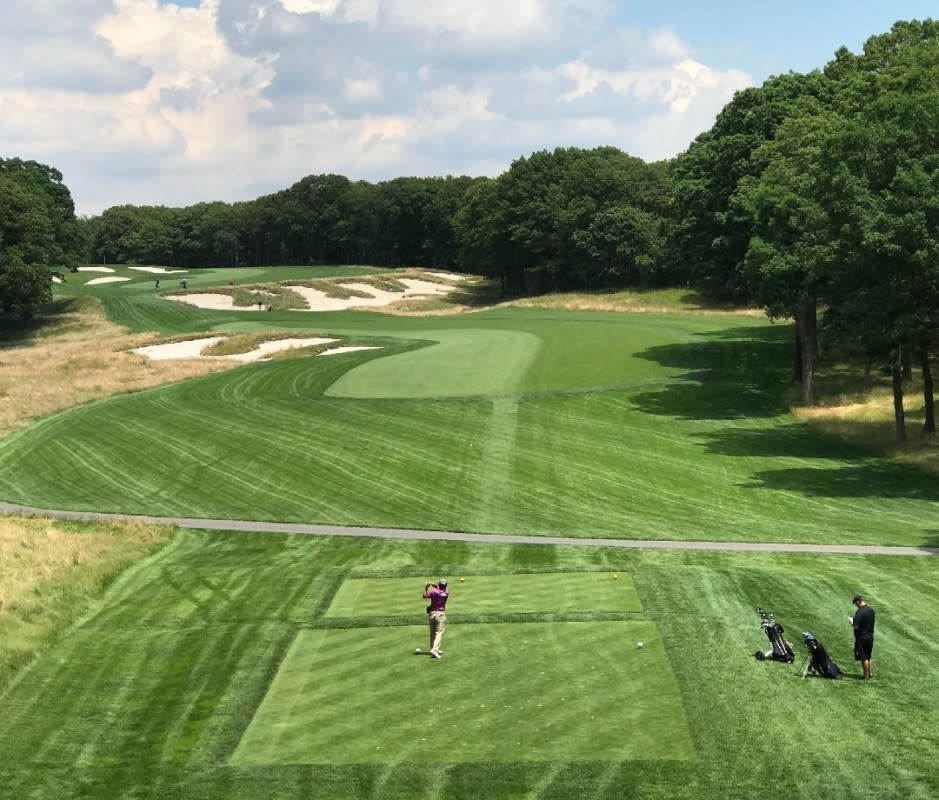
Nicholas Hegel McClelland
“The People’s Country Club” on Long Island is one of the toughest tests of golf open to the public. Both visually stunning and intimidating, Bethpage Black will eat your lunch, given the opportunity. The rough is long and lush. Hit it beyond the fairway and you’ll be lucky to find your ball let alone advance it much. It’s also a tough eight-mile walk, with elevation changes equivalent to a couple dozen flights of stairs.
A.W. Tillinghast designed some of the best private courses in the country, both tracks at Baltusrol, both at Winged Foot and San Francisco Golf Club. But Bethpage Black is one of the rare “Tilly” designs anyone can play. The par-5 fourth hole and par-4 15th are both all-world golf holes. The course, which has hosted two U.S. Opens and a PGA Championship, is set to host the Ryder Cup in 2025.
Best Golf Course in Las Vegas: Shadow Creek (Las Vegas, NV)
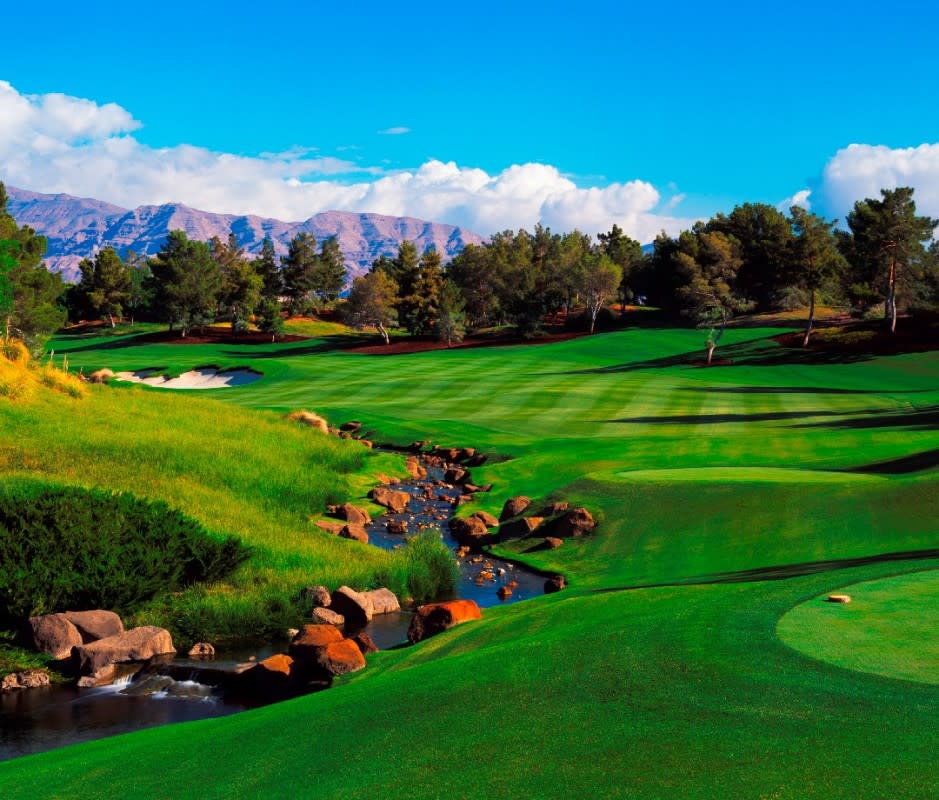
Courtesy of MGM Resorts International
It’s Vegas, baby! MGM Resorts International’s Shadow Creek is less than 30 minutes from the Strip, which means it’s still officially in the desert—and, therefore, those impossibly lush tree-lined fairways, streams, and waterfalls were all exorbitantly man-made. Sculpted with rolling hills, manufactured elevation changes, and something north of 20,000 planted trees, this Tom Fazio-designed showstopper was created with a reported budget of $47 million way back in ancient Vegas history (1989). Turns out building your own desert golf oasis doesn’t come cheap—and neither does playing it. The greens fees here are now pushing $1,250, so hopefully anyone teeing off had a good run at the tables the night before.
Best Mountain Golf Course: The Broadmoor East (Colorado Springs, CO)
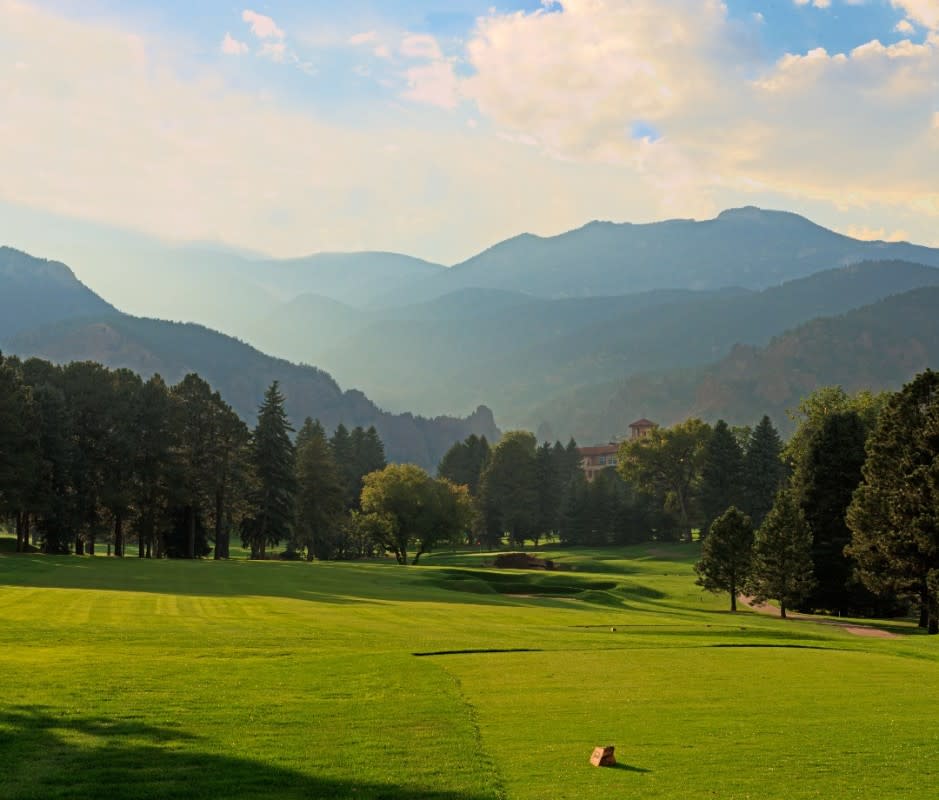
Courtesy Image
The Rocky Mountains make a helluva backdrop for golf. Nestled among the trees just southwest of Colorado Springs, The Broadmoor’s East course offers stunning views and good test. The design is a combination of two nines, one by Donald Ross and another constructed 30 years later, in 1948, by Robert Trent Jones. There's the potential for tree trouble off nearly every tee and the greens are devilishly deceptive—so pack your A-game if you want to score well. Plus players need to work out the math on how much farther the ball flies at altitude since the course sits 6,400 feet above sea level at the base of Cheyenne Mountain in Colorado Springs, CO. If you want to play here, just make sure you’re a hotel guest (or a member).
Two of golf’s all-time greats, Jack Nicklaus and Annika Sorenstam, have lifted trophies at this classic Donald Ross/Robert Trent Jones Sr. design. On top of that, it’s parked 6,400 feet above sea level.
Best Historic Golf Course: Pinehurst No. 2 (Pinehurst, NC)

Courtesy Image
The Village of Pinehurst, a nine-course golf mecca in the Carolina Sandhills, is billed as the home of American golf, a designation that’s tough to dispute. When Pinehurst No. 2 hosts the 2024 U.S. Open later this summer, Donald Ross’ turtleback greens will be so difficult to hold, some of the best golfers in the world will find themselves held low or even in tears—the USGA might want to strategically place some tissue boxes on the tees.
On days it’s not tuned up for a major championship, No. 2 is still a brute that can only be taken down with strategically placed shots. Every hole demands focus and requires a keen understanding of where you want to be and the spots you need to avoid.
The course twists and turns through a rough-free cathedral of longleaf pines and a mélange of native hardpan sand. Each hole leads into devilish green complexes; playing them feels like trying to stop a ball on a turtle’s back. Not to be missed: The Cradle, Pinehurst’s nine-hole short course dubbed “the most fun 10 acres in all of golf.”
While Donald Ross eventually designed 400 courses across the U.S. and Canada, his early work on Pinehurst No. 2, which dates from 1907, remains his masterpiece. In 2010, the course was restored to Ross’ original intent by Bill Coore and Ben Crenshaw and is now an anchor site for the U.S. Open, with events planned for 2024, 2029, 2035, 2041, and 2047.
Best Resort Golf Course: Pacific Dunes (Bandon, OR)
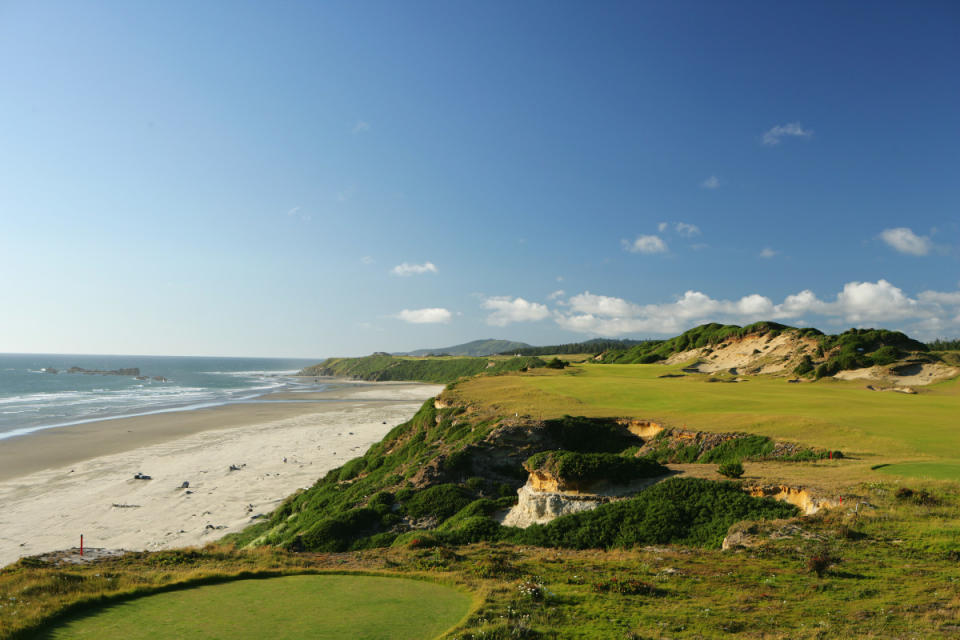
David Cannon / Contributor /Getty Images
There are golf resorts and then there’s Bandon Dunes—the purest links golf experience outside of Scotland and as close as it gets to a stateside golf pilgrimage. It’s the only destination in the world with five Top 100 courses on the same site—no small accomplishment for a place born in 1999—but Pacific Dunes stands primus inter pares. The Tom Doak design traverses steep cliffs above the wild Oregon Coast with vistas that will leave players reeling.
Not only does Pacific Dunes offer some of the best seaside golf on the planet, the architecture breaks the mold for modern American courses. It features inland holes and ocean holes spread between native Oregon shore pines and towering dunes.
Doak's par-4 ninth hole plays up a hill and second shots are hit to one of two separate green complexes, depending on where the greenskeeper decides to put the hole for the day. Being at Bandon is a thrill in and of itself, but it gets even better if you pack your knock-down game. It’ll come in handy at Pacific’s 13th hole, one of the best par-4s on the planet; it plays dead into the prevailing wind.
Oh, and the back 9 feature four par-3s and three par-5s, including the long-and-tough 18th. Read our full review of Bandon Dunes Golf Resort.
More of the Best Golf Courses in Every State
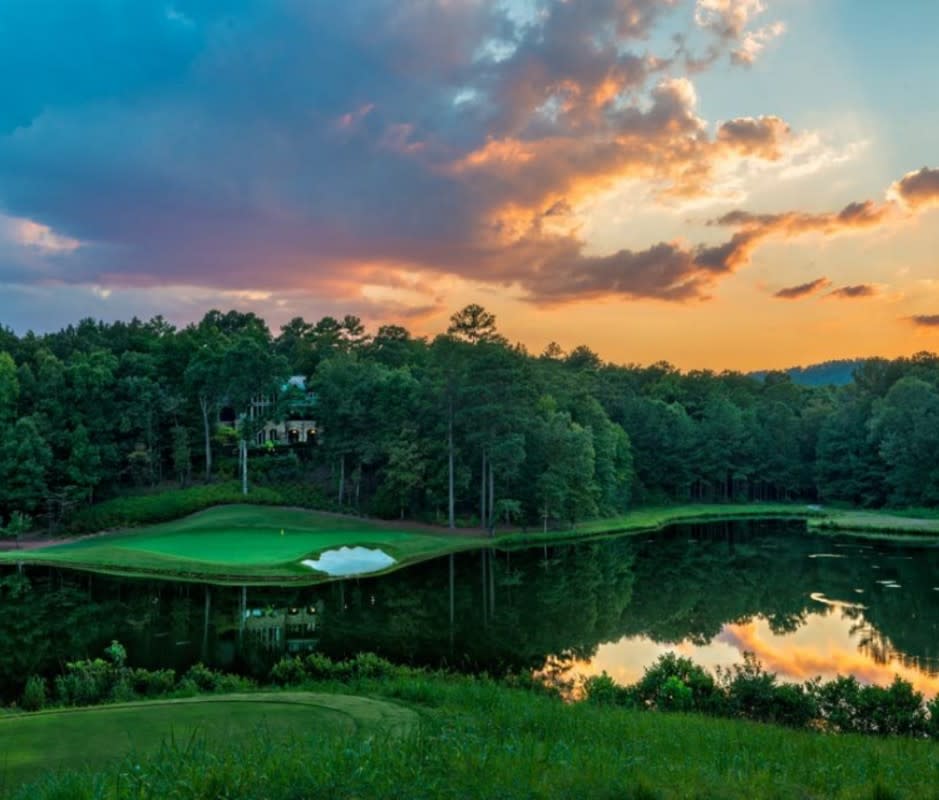
If FarmLinks isn’t the best kept secret in the country, it’s undoubtedly the best kept secret in the South. Grab a chilled apple (talk about Southern charm) beneath the loblolly pines and brace yourself for a world-class routing at this rambling 3,200-acre property an hour southeast of Birmingham, AL.
Your jaw will drop while watching your ball in flight against the distant Appalachian foothills at the fifth hole (aptly named Hang Time), a 210-yard par-3 that nosedives 172 feet to a portrait-perfect putting green. Historical markers on each hole reveal that Spanish explorers and Civil War soldiers marched through the grounds in the days of yore. Somewhere between walking up the 18th fairway and entering Old Tom’s Pub, you’ll realize that one round at FarmLinks just isn’t enough.

Situated off the Glenn Highway outside of Anchorage, AK, this military-run operation at the foot of the Chugach Mountains just so happens to be the northernmost 36-hole golf facility in the country. Golf season is short in the Last Frontier and options are limited—there are only twentysomething courses in the entire state—but what Alaska lacks in quantity, it more than makes up for with wild and rugged beauty. As you navigate your way over and around the shimmering Ship Creek, don’t be surprised if both moose and bears join your foursome.
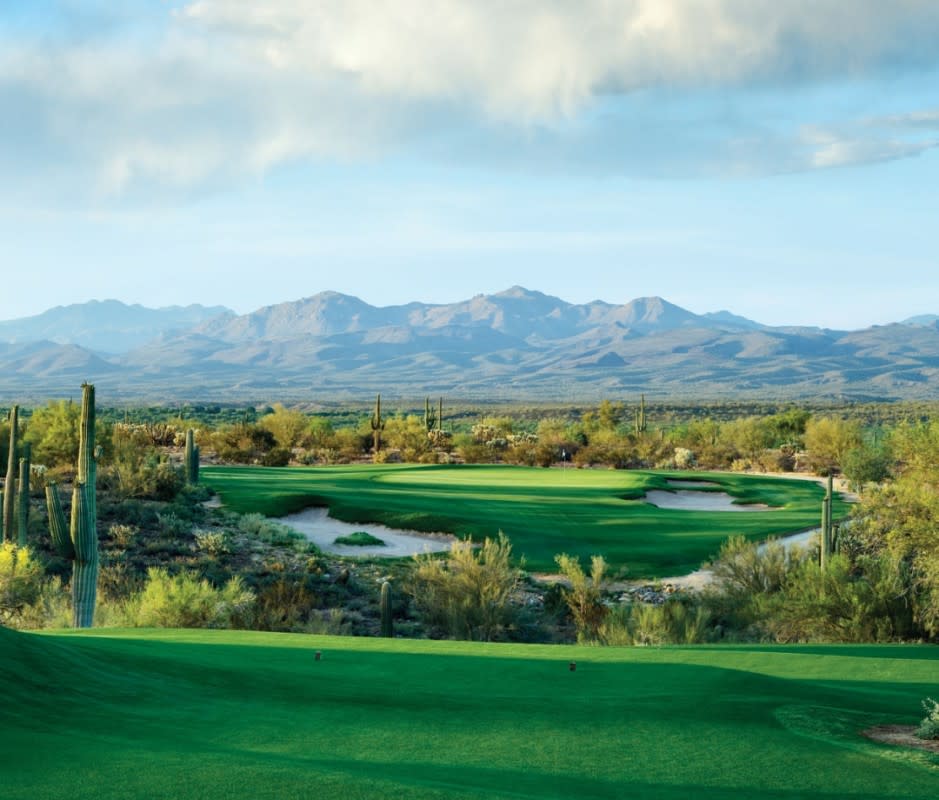
Scottsdale, AZ is the heartbeat of desert golf, but the Grand Canyon State’s best one-two punch is a casino course combo thirty minutes northeast on Fort McDowell Yavapai Nation land. Most of We-Ko-Pa's well-deserved love goes to the Saguaro Course, a Coore/Crenshaw blueprint that naturally unspools in the majestic Arizona landscape. Both it and its sister course, Cholla, offer players unbroken views of multiple mountain ranges—the Superstitions, McDowells, and Mazatzals to name a few.
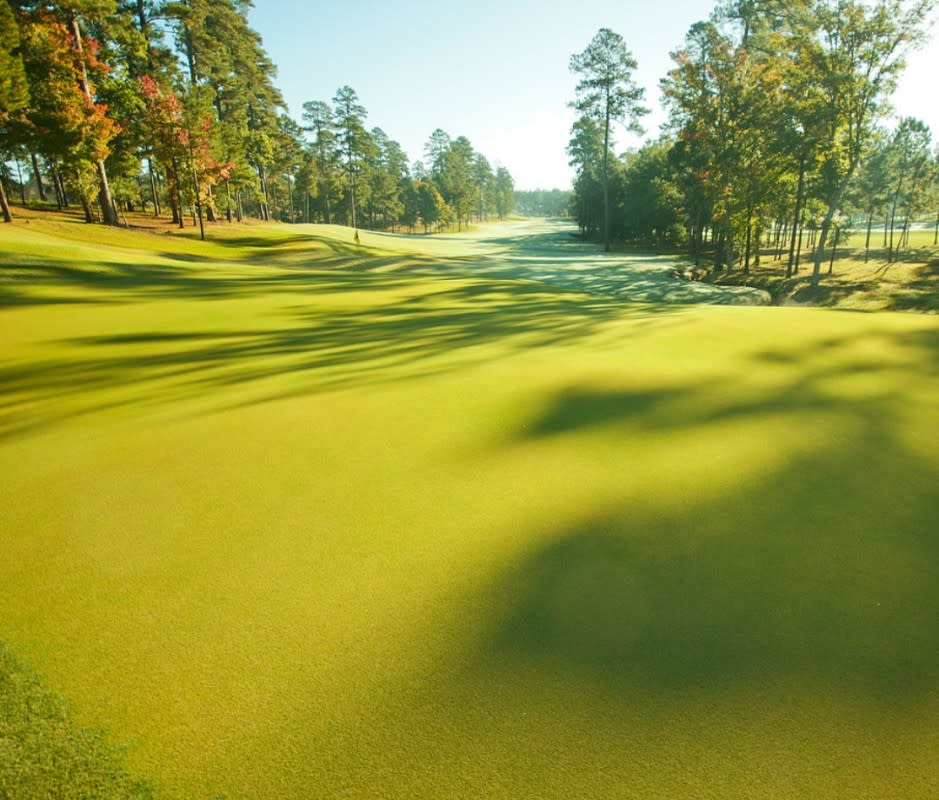
Any course architect who starts and finishes players on par-5s is immediately added to the Christmas card list. In tiny El Dorado, AR, not far from the Louisiana state line, Mystic Creek Golf Club shines, one through eighteen, across a vast swath of cathedral pines reminiscent of a certain course in Georgia that awards green jackets (even the clubs’ logos are similar). Like Augusta, Mystic Creek’s pure Bermuda grass greens feature lots of slopes, so make sure to warm up on the practice green before your round here.
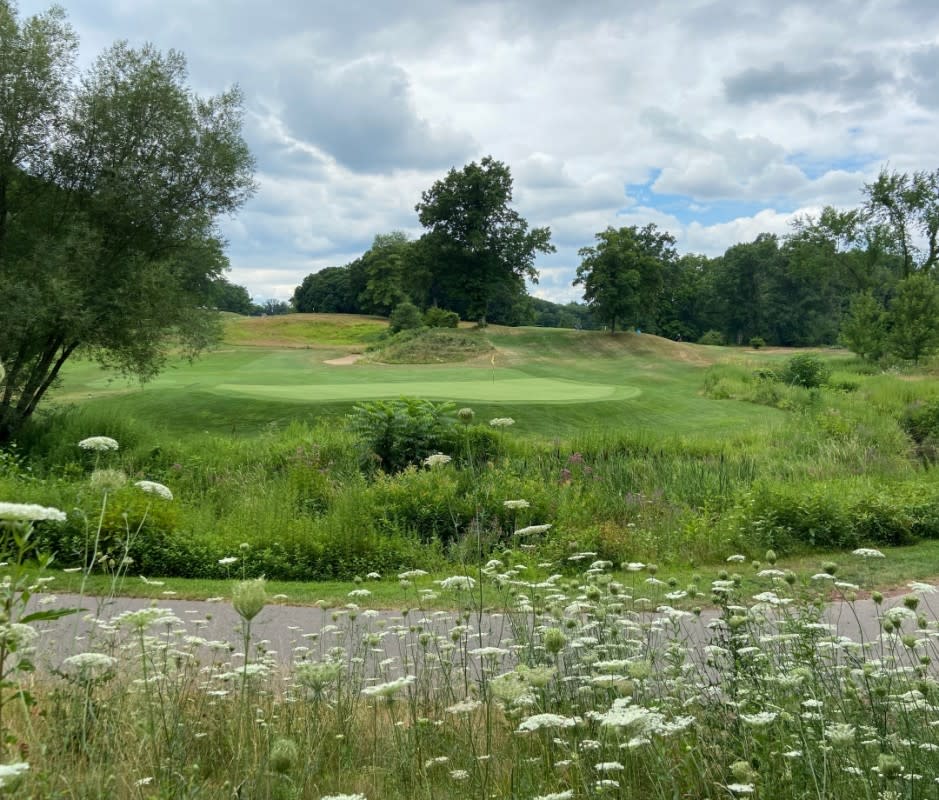
A lot of munis can be filed under “goat track” due to their less-than-ideal playing conditions. Not Keney Park, a restored 1927 Devereux Emmet/Robert “Jack” Ross gem owned by the city of Hartford, CT. The best part? You’ll never have to pay more than $45 for eighteen holes—and that’s a non-resident weekend rate.
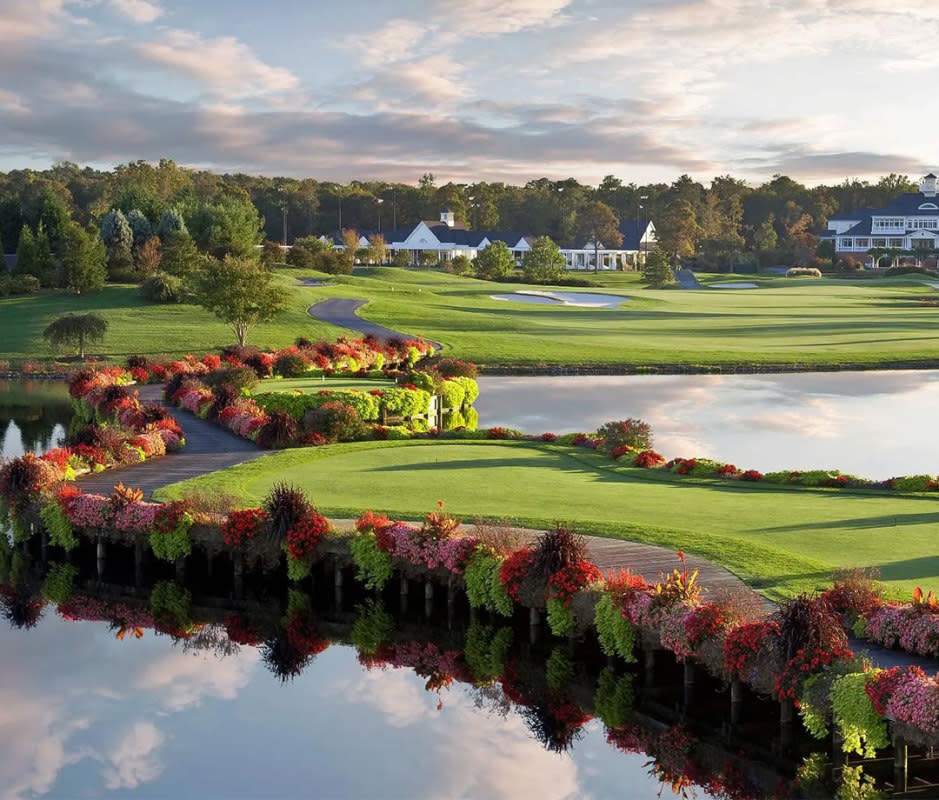
Courtesy Image
A short jaunt from both Lewes and Rehoboth Beaches, this pair of nines of nines at Baywood Greens represents the finest public golf in the First State. The Woodside nine plays through the hardwood forest with water lurking on many holes. The par-five fifth looks like a simple proposition—fly the massive centerline bunker to a large landing area—but getting home in two shots is a tall order as the hole measures 603 yards. The fairway narrows significantly and twists left for the layup, so players need to mind their yardages. As the name suggests, Waterside nine tests golfers with numerous forced carries over liquid H2O, none more dramatic than the long par-four 14th. Golfers have a choice: Take the long route down the right to the well-bunkered dogleg left green or try to land a tee shot on an island fairway for a shorter approach and better angle.
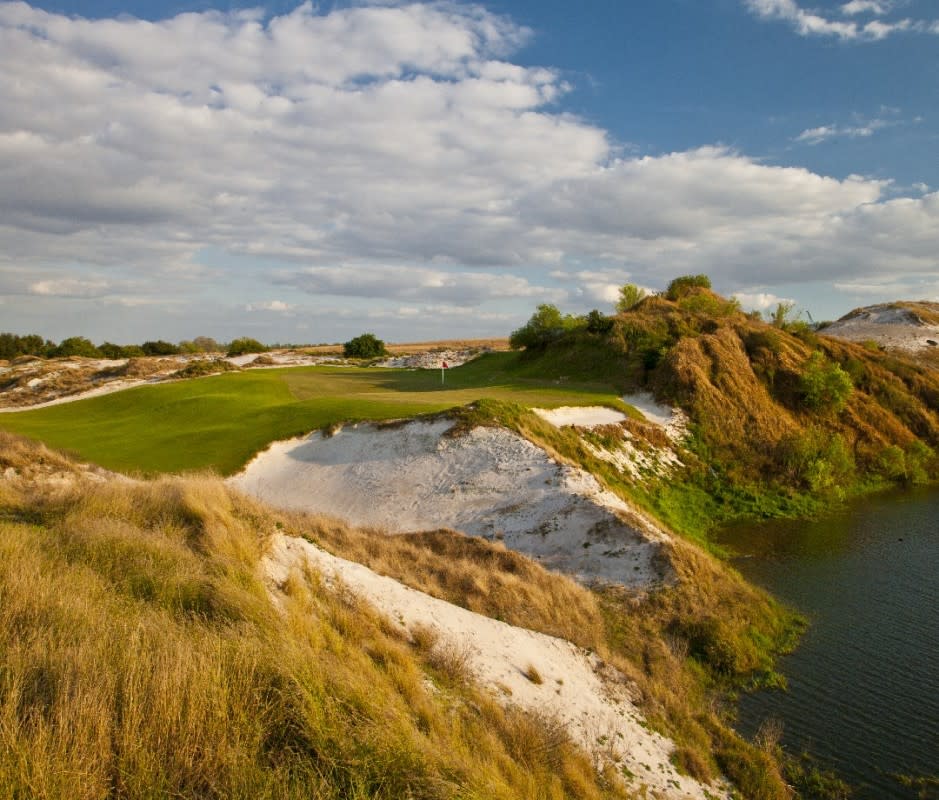
Courtesy Image
The bar for golf in Florida is high. There are more than 1,250 golf courses in the Sunshine State and many open to the public are truly fantastic—TPC Sawgrass, PGA National, and Bay Hill, to name a few. But Bill Moore and Ben Crenshaw’s Streamsong Red is our favorite in Florida. Part of a golf trilogy at the Streamsong resort, the Red course was constructed on the site of a former phosphate strip mine (as were the Blue and the Black courses). The views are wild. With massive mounds covered in wispy grass and epic waste areas, it doesn’t play like your average course south of the panhandle. Balls take big bounces in the fairway, and many green complexes play like a links course you’d find in Ireland. There are a few forced carries, like on the signature par-3 16th, but overall the course is one of the most fun in America.
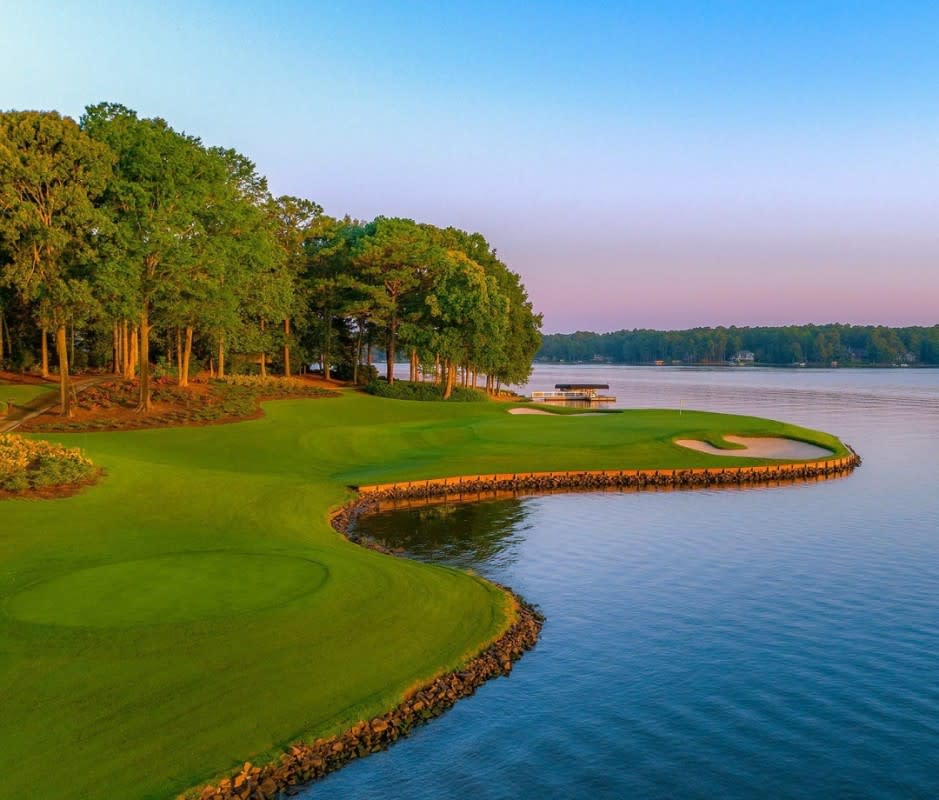
When you’re dealing with sticky Bermuda rough, the friendly fluff of Zoysia fairways, like those at this recently renovated Nicklaus layout, are a balm to any golfer’s soul. Located ninety minutes east of Atlanta, Great Waters delivers not only one of the finest lakeside stretches in America—its last eight holes skirt Lake Oconee’s idyllic waterside, offering a deluge of cove carrying shot opportunities—but one of the most entertaining back-nine routings in the country. After one lap around these immaculate azalea-laden grounds, you’ll be itching for a bonus eighteen.
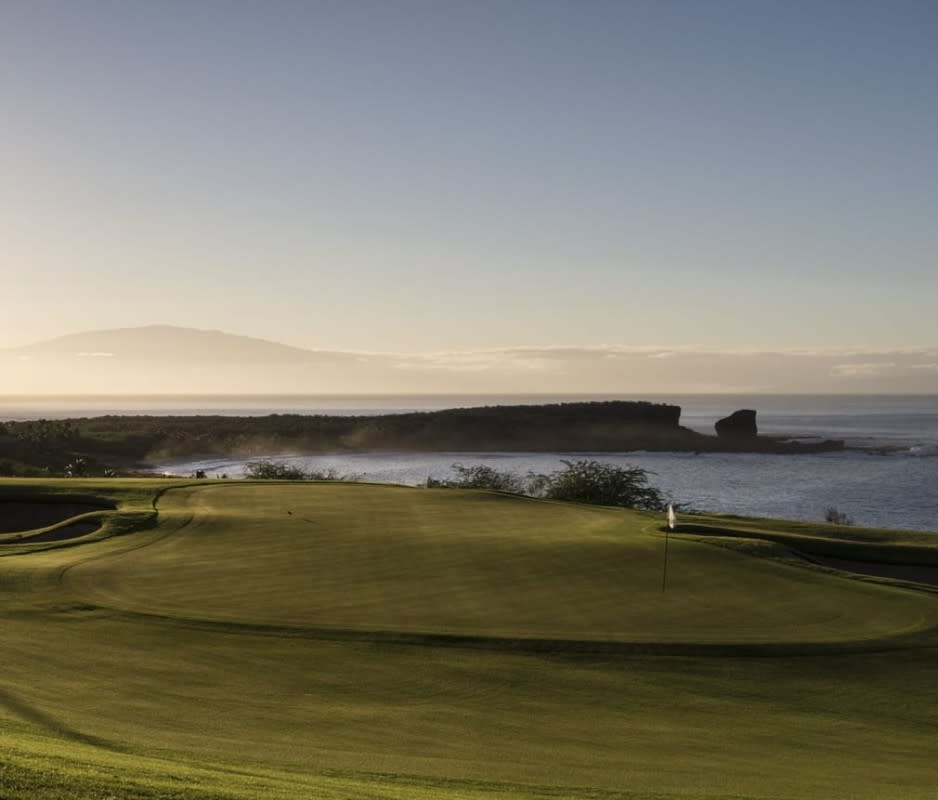
By the time you make the turn at Lanai’s only 18-hole course, you’ll have run out of adjectives to describe this secluded oceanfront paradise. And that’s before Jack Nicklaus blows your mind with his cliff-hanging back-nine on the edge of Hulopo’e Bay, where every shot could have its own page in your 2023 golf calendar. Forced 200-yard carries over crashing blue surf aren’t exactly a salve for the ol’ handicap, but they do keep us honest. Mahalo for swinging away.
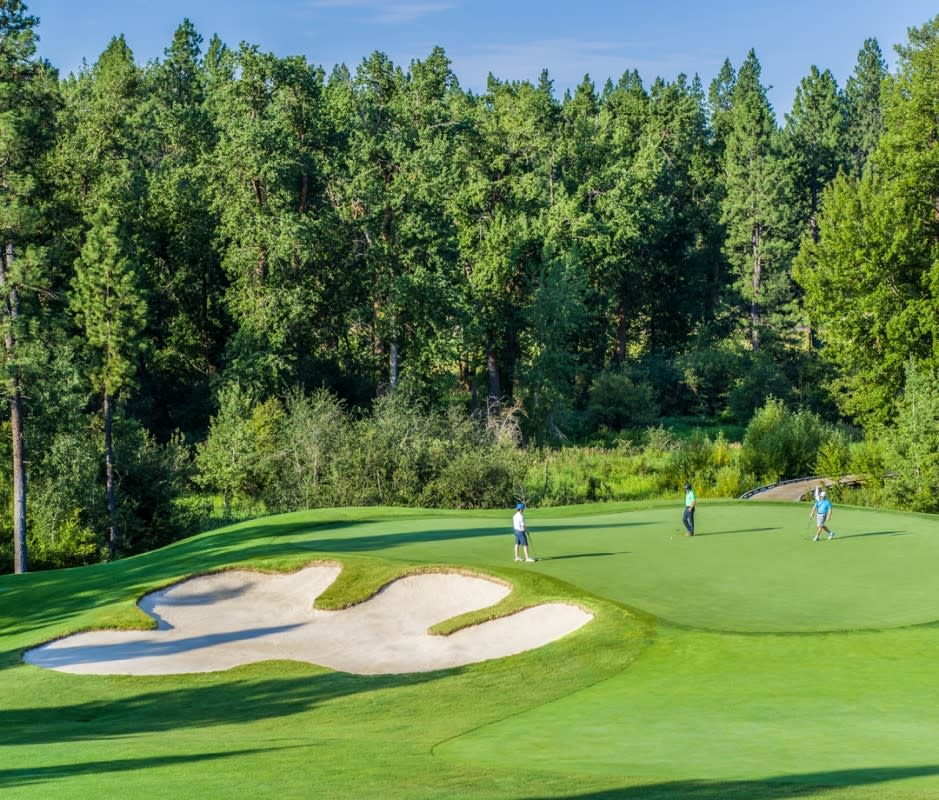
One of the country’s premier resort courses sits on tribal land, that of the Coeur d’Alene Tribe, in the Idaho Panhandle. At Circling Raven, you’ll play your way through a maze of wetlands (where moose like to dine) and conifer-lined golden hills embroidered by native grasses. Not only is Circling Raven one of the most fun eighteens you’ll play in Idaho, it’s one of the best layouts in the entire country. Better yet, tee times can be had for as low as $89, making it one of the best bang-for-your-buck rounds in America.
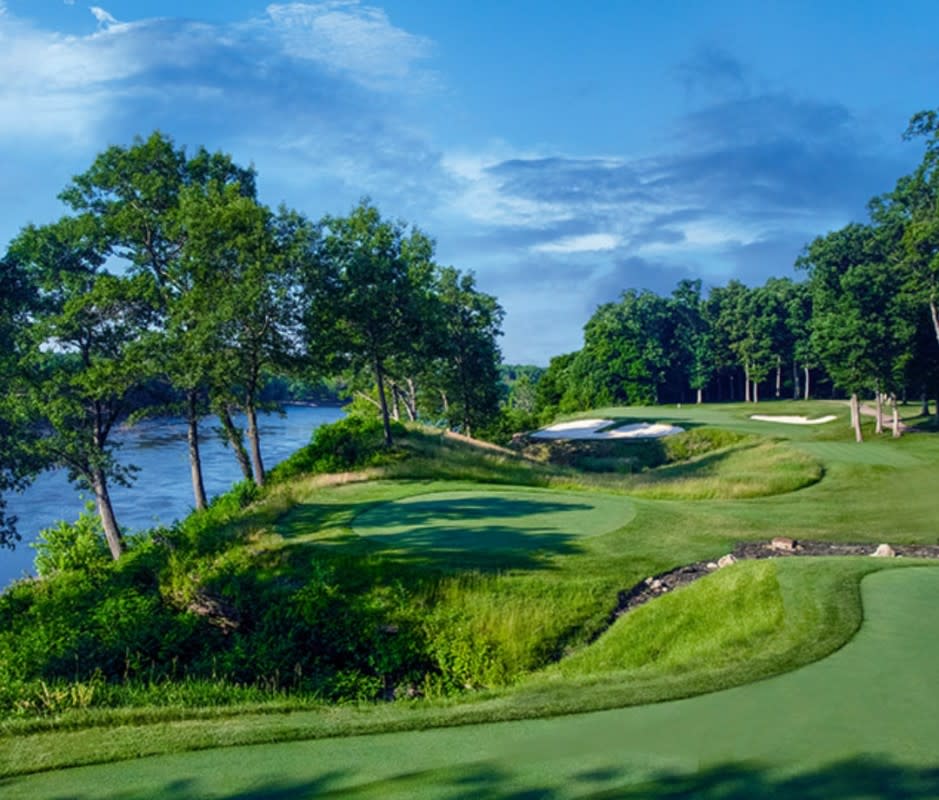
The host course of the annual John Deere Classic, TPC Deere Run offers amateur golfers the opportunity to tee it up where the pros play each summer. Short hitters, including Zach Johnson and Steve Stricker, have had a lot of success (and made a boatload of birdies) on this course’s many doglegs. Mother Earth, the 153-yard par-3 16th hole above the Rock River, isn’t a big poke, but greenside danger will punish the errant tee shot.
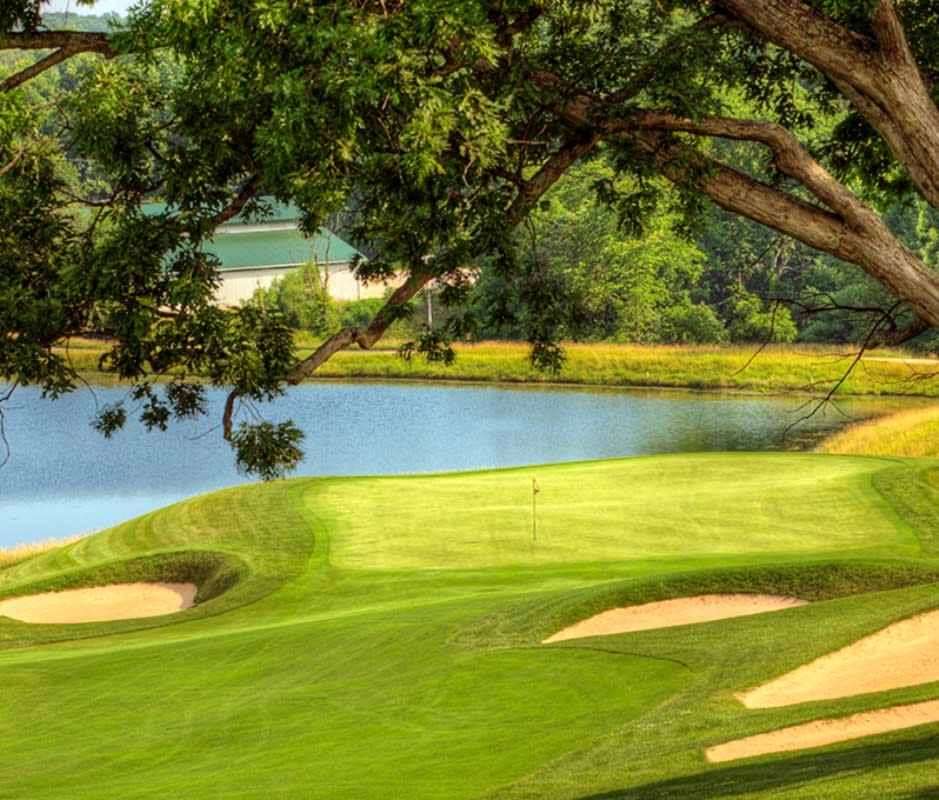
A revamped 1917 Donald Ross layout where Walter Hagen won the 1924 PGA Championship? Um, yes please. Ross’ trademark undulating greens are on full display at the eighth hole, which drops six feet from back to front. For the resort’s best views and Indiana’s hilliest topography, you’ll also want to play the Pete Dye Course, which Dye originally sketched out on a napkin. If you wind up in one of his famous volcano bunkers, be sure to have your playing partner hit record before you take your next shot.
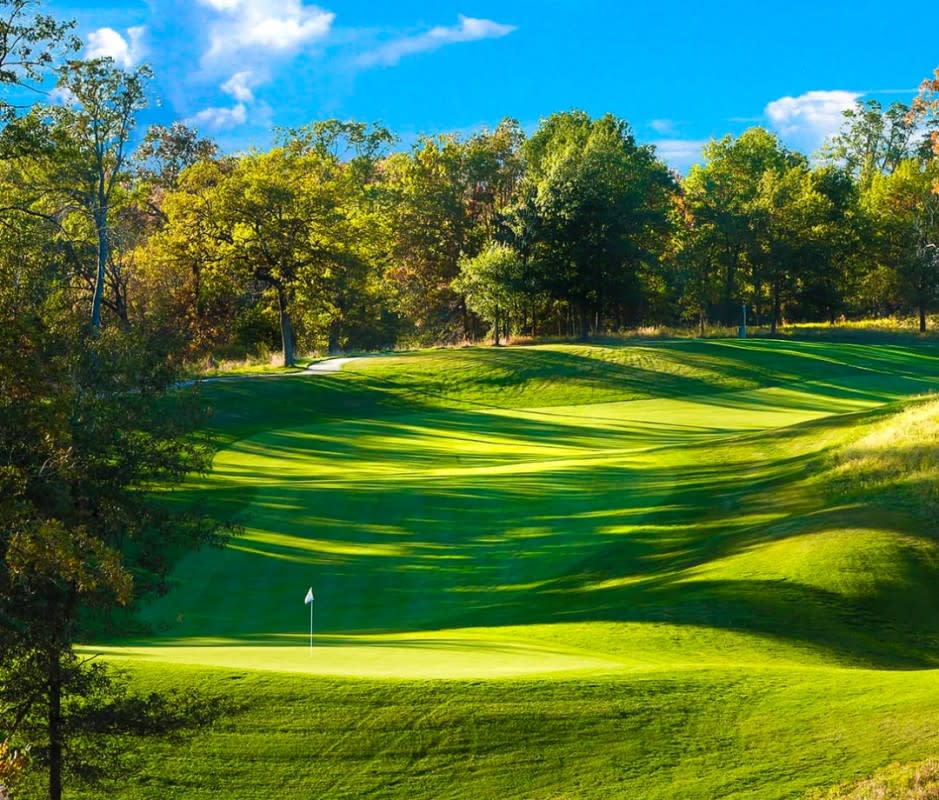
Natural streams course their way through rolling terrain and groves of native oak trees at this former cattle ranch in Burlington, IA. Given the Midwest’s humid summers, it’s an anomaly to play on bent grass fairways in the midsection of America, especially in the Hawkeye State. The photogenic thirteenth hole is a snapshot waiting to happen.
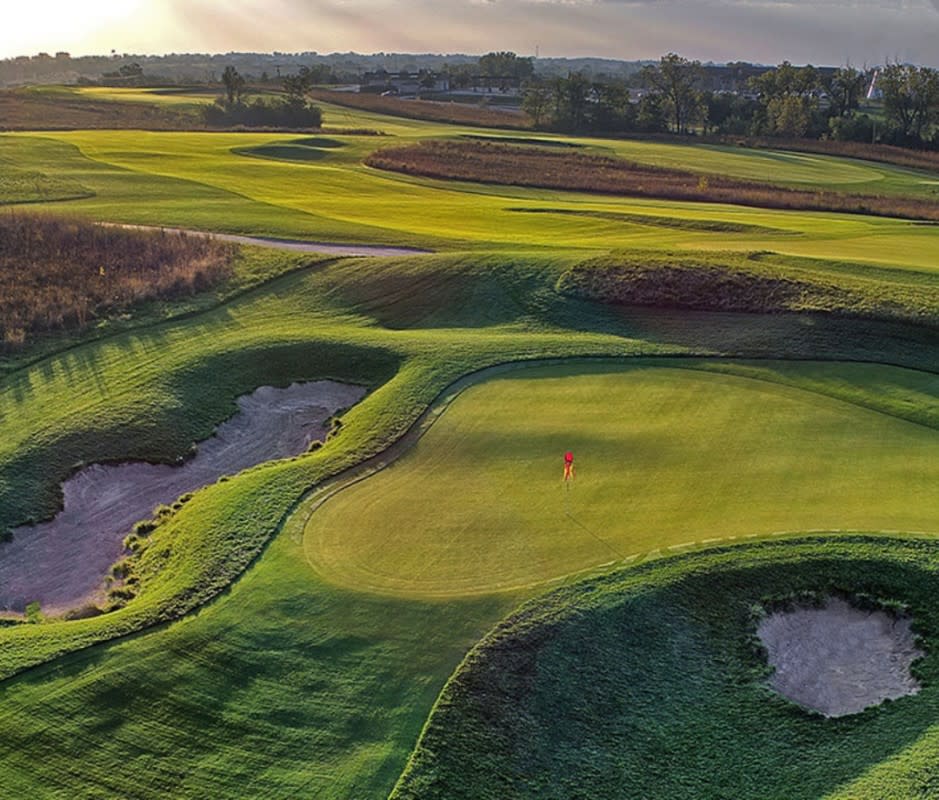
There’s nothing plain about this Great Plains golf course an hour’s drive from Kansas City. Owned by the Prairie Band Potawatomi Nation, it’s touted as one of the top casino courses in the country. Standout holes include number nine, a lengthy par-4 inspired by Augusta National’s famous finishing hole, and the risk-reward 18th, where a double fairway entices players with a shortcut over a brush creek. For some of us, that’s code for “go for it.”

All hail the course that tips out just a hair over 6,700 yards. That’s the case with Lassing Pointe, located in northern Kentucky just across the state border from Cincinnati, OH. It’s county-owned, and the money you save with your $43-max greens fee can go toward a post-round tipple (or two) of Kentucky’s finest bourbon. You’re welcome.
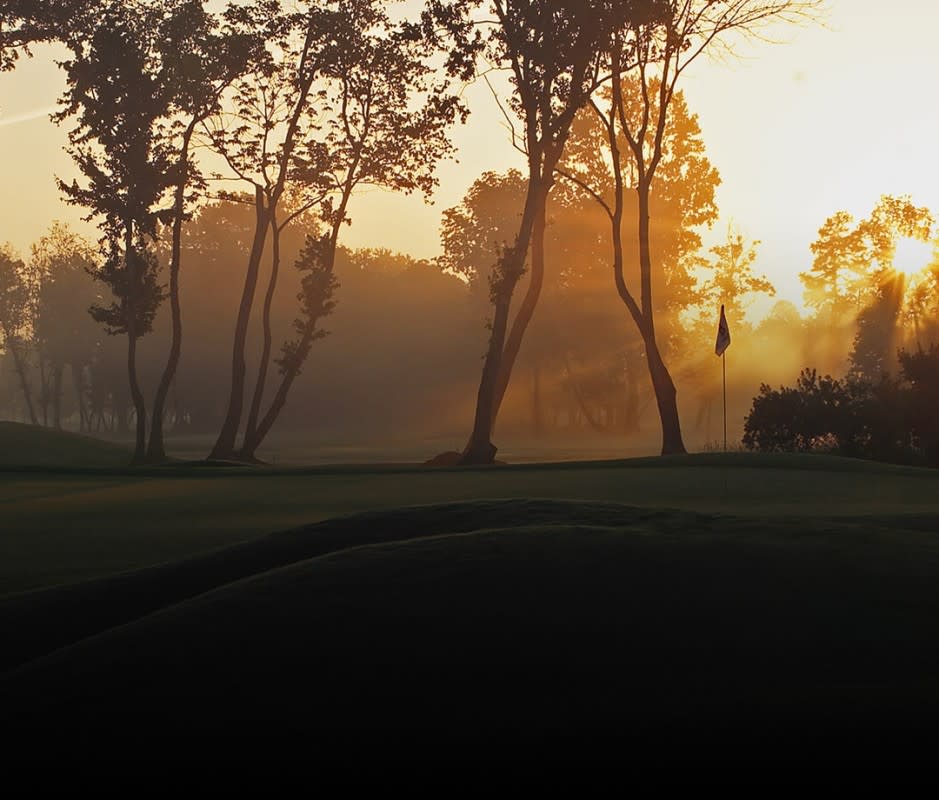
It’s always a treat to tee it up where the pros play. At TPC Louisiana, site of the annual Zurich Classic of New Orleans, you can walk the same fairways that host the PGA’s best each April. The stadium-style course sits on 250 acres of Mississippi River wetlands—in other words, it’s a swamp. There are alligators, pot bunkers (thanks, Mr. Dye), and old-growth cypress trees, including a stately 100-foot-tall cypress in the middle of the fairway on the drivable par-4 13th hole.
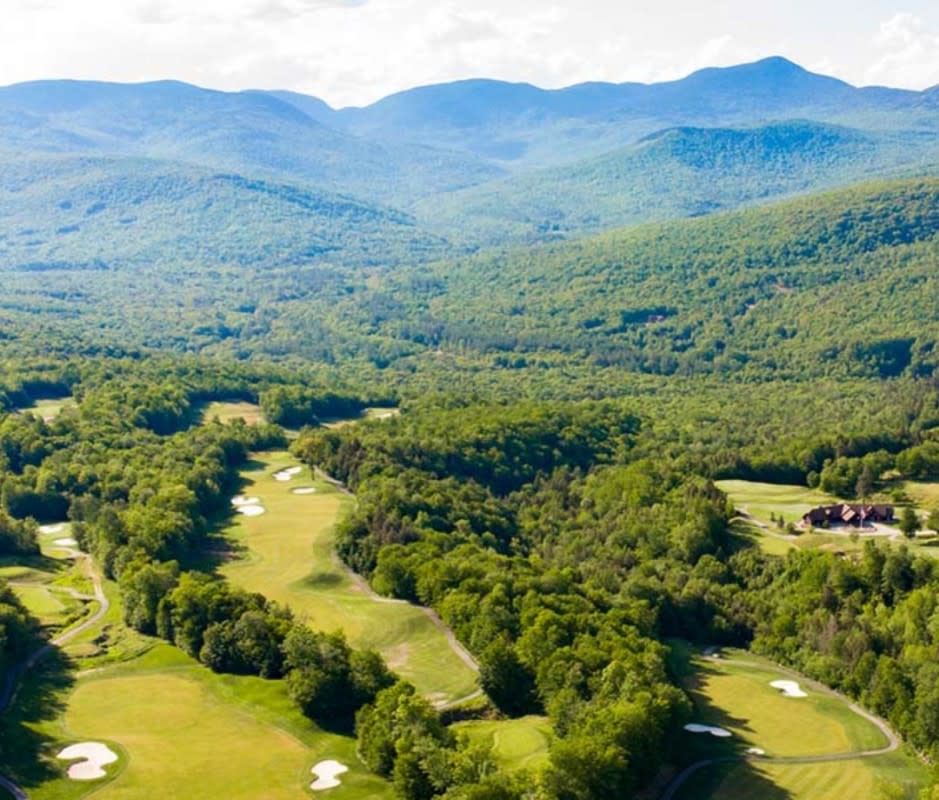
Sunday River could make a case for the most scenic course in all of New England. Backdropped by the Mahoosuc Range, golfers are treated to stunning mountain scenery on every hole. Robert Trent Jones Jr. sketched its dramatic routing through the majestic hardwoods of Maine; the course gifts players with generous fairways but challenges them with tough greens.
The signature 14th hole, a lengthy par-3 protected by a mammoth waste bunker, plays into a Redan-style green. Translation: It’s well-defended, making par a hard-earned feat.
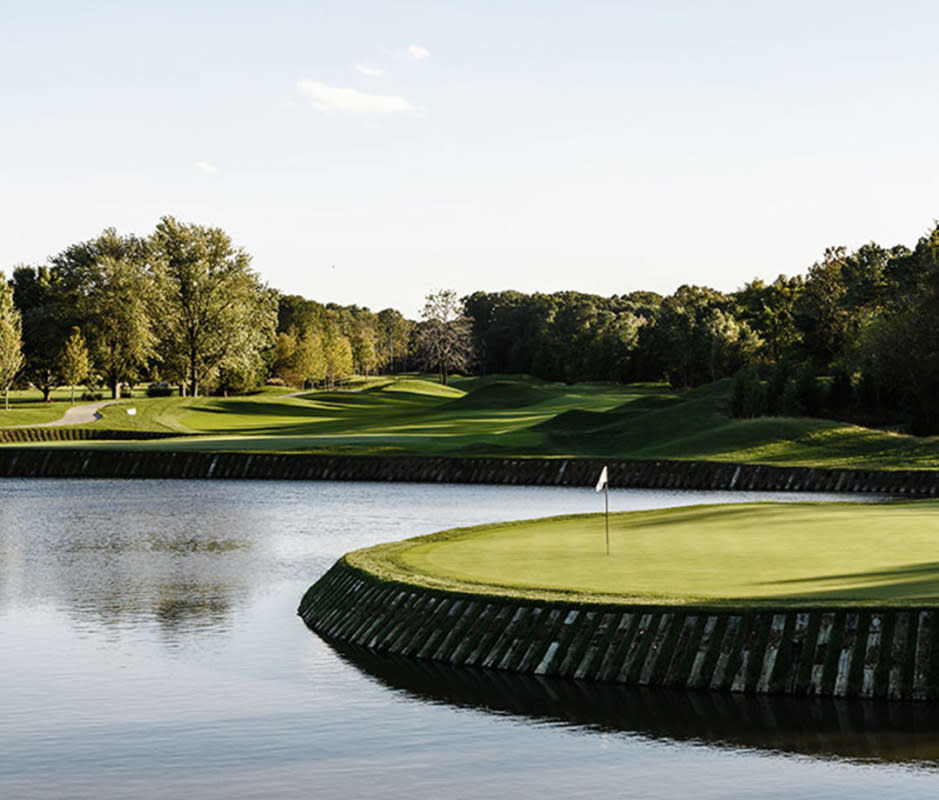
Courtesy Image
Set in the haughty vacation town of St. Michael on Maryland’s eastern shore, playing Links at Perry Cabin requires a stay at the Inn, but it’s worth the splurge. The course was Pete Dye’s final design before his death in 2020 and his signature visual subterfuge is everywhere. There's plenty of railroad tie framing and the par-three 17th plays to an island green (where have we seen that one before?). Plus, the 18th is a cape hole. But it’s not all formulaic Dye. The 245-yard, par-three 7th plays to a Biarritz green with a similar feel to the 9th at Yale Golf Club, but with a much longer carry over water.
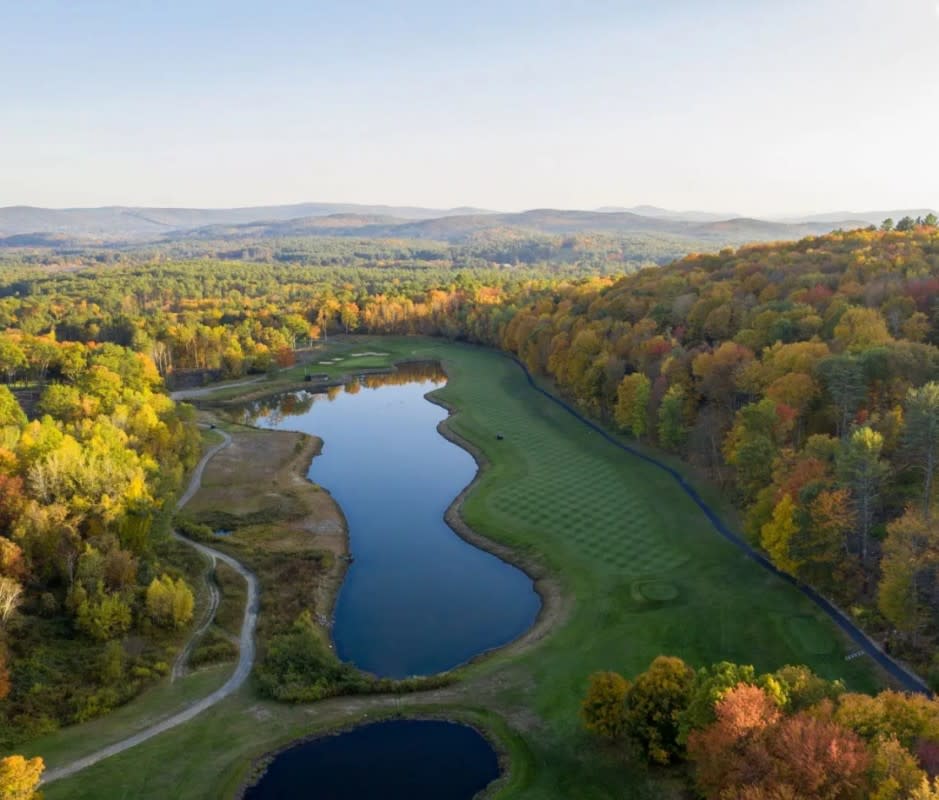
Hip name? Check. Diverse routing? Check. A-plus setting on the eastern edge of the Berkshires? Double check. The most notable hole here is certainly the lengthy par-5 eighth, which is guarded by woods and a giant lake that make it a tall task for even the biggest of bombers.
“Many a golfer’s ashes will be scattered over this hole,” advises the course website. “But well before they had intended to leave this vale of toil and sin.”
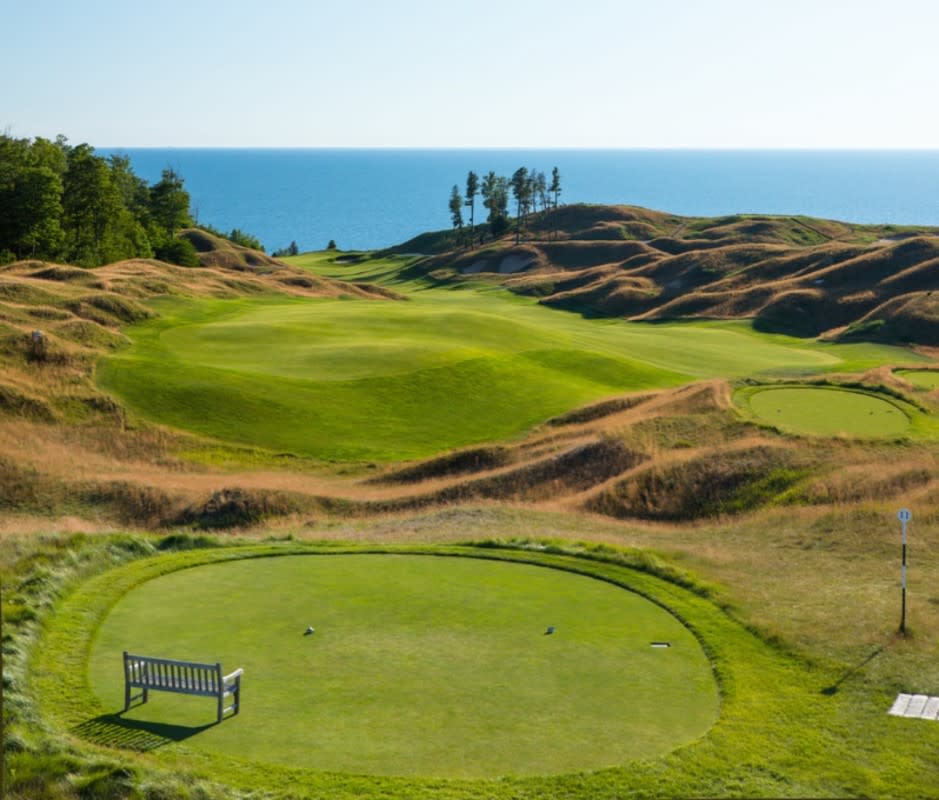
It’s Pebble Beach for less than half the price. Located on the shore of Lake Michigan, Arcadia Bluffs is often overshadowed by Whistling Straits, its high-ranking rival across the lake in Wisconsin. But don't be fooled: This is one of the best public tracks in America in its own right. The layout is highlighted by enchanting windswept bluffs and the scenic back-to-back punch of Nos. 12 and 13, which are perched some 200 feet above the lake’s Caribbean-hued waters.

Courtesy Image
This challenging woodlands course is named after the late Arnold Palmer’s dad. It rubs shoulders with multiple central Minnesota lakes and snakes its way through scenic wetlands and even swaths of sandy terrain—something visitors might not expect in this section of the country. There aren’t many flat lies out here, but there are views aplenty and bargain rates for a track of this caliber.
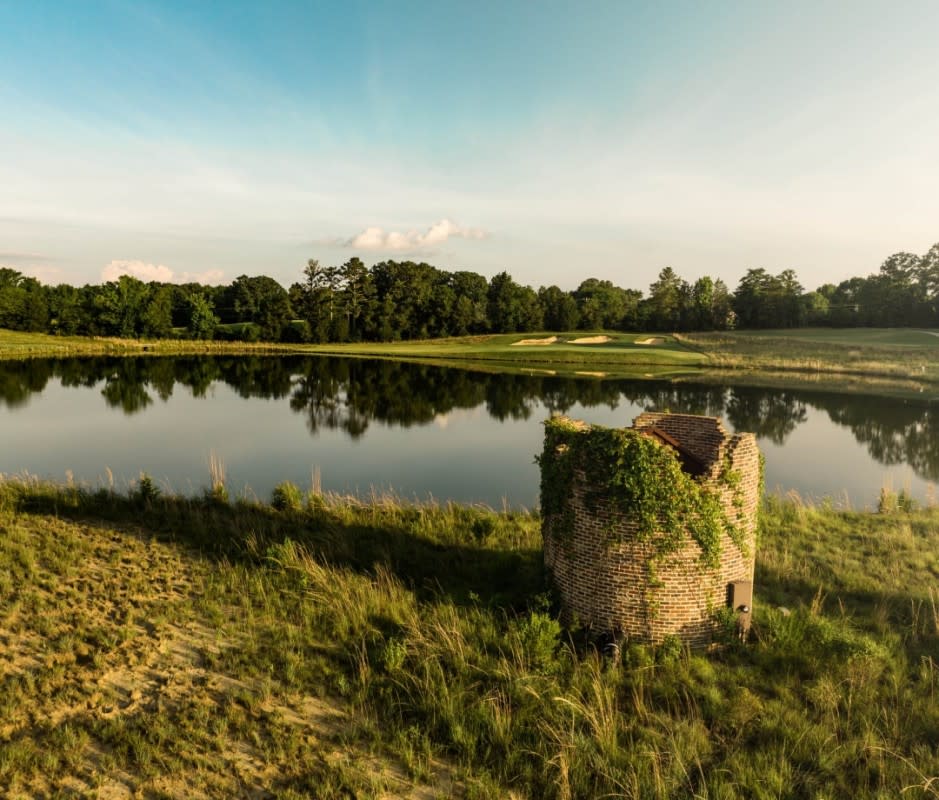
Over the Mississippi Black Prairie and through oak tree woodlands to a Gil Hanse masterpiece we go. The wide-open Scottish-style layout, designed by the 2016 Olympics’ course designer, ebbs and flows with the gentle surrounds of this Magnolia State tract. Dubbed “nature’s golf,” Mossy Oak’s minimalist routing makes for a graceful walk on a course you certainly won’t forget.
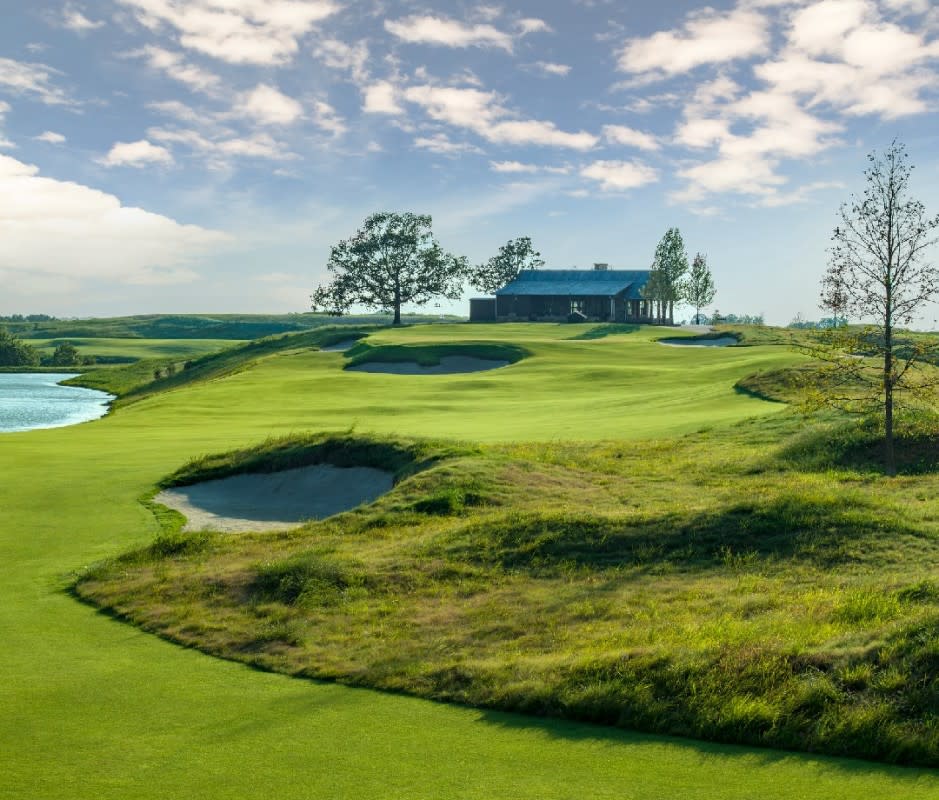
Courtesy Image
Thanks in part to Bass Pro Shops billionaire Johnny Morris and his vision for the posh Big Cedar Lodge as America’s “next great golf destination,” Branson, MO, has become a perfect spot to rendezvous with friends or family for a golf trip. The resort features three 18-hole courses, including the Tom Fazio-designed Buffalo Ridge and Payne’s Valley (Tiger Woods’ first public track), as well as a pair of short courses. Our pick of the bunch, created by architects Bill Coore and Ben Crenshaw, Ozarks National is a beautiful dance across a southern Missouri mountain. Fairways play along ridges and over ravines, moving with the land. Numerous holes insist on forced carries over gorges. The slopes and lies often push players’ hands and shots, but also offer opportunities to use the golf brain’s more creative side.
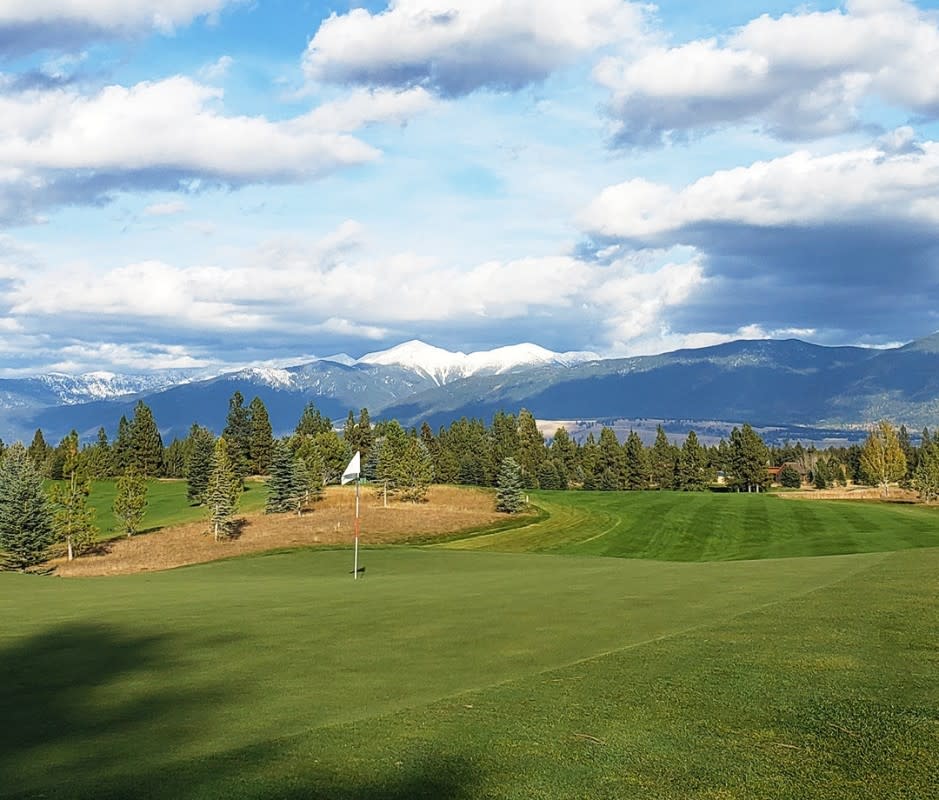
Three-time Masters’ champ Sir Nick Faldo co-designed this Treasure State gem located just a few minutes from the Canadian border. Here, peak conditions and snow-capped mountain vistas are the norm. Daylight extends past nine o’clock come summertime, making this Big Sky outpost in the northwest reaches of the state more than worth the long trek.
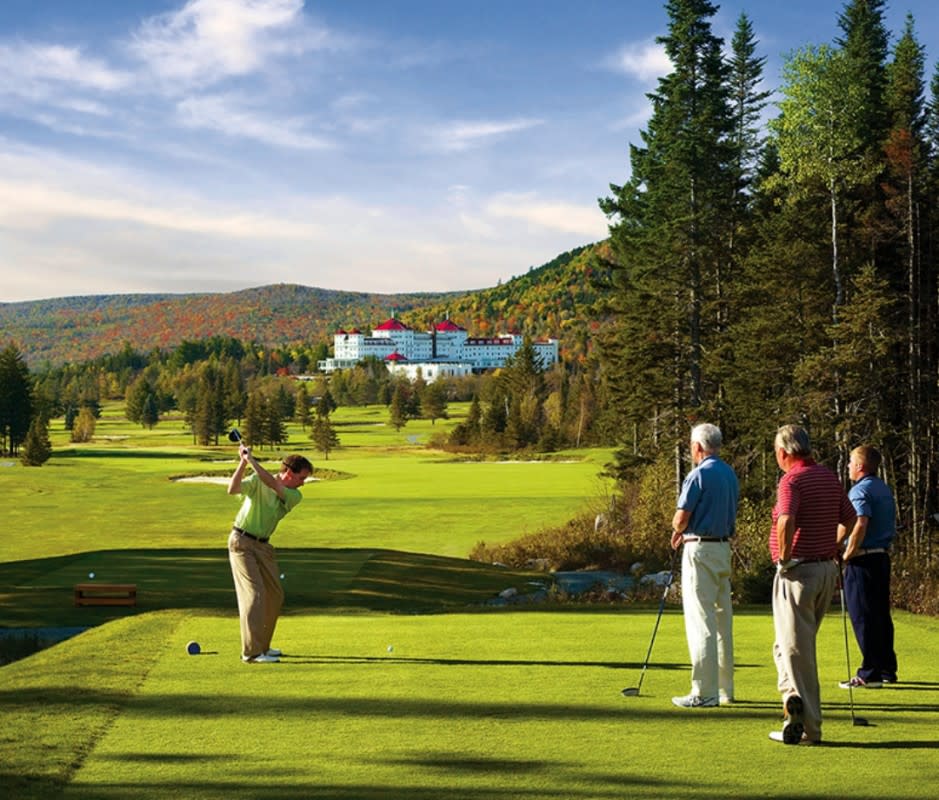
The White Mountains’ Presidential Range drew Donald Ross to New England in the early 20th century, and he completed the 18-hole Mount Washington Course in 1915. Brian Silva touched the property up in 2008, restoring bunkers and golden age Ross elements. The red-roofed Omni Mount Washington Resort is a grand ole hotel evocative of a certain Wes Anderson film; for a picturesque view of it, head to straight to the 11th tee box.
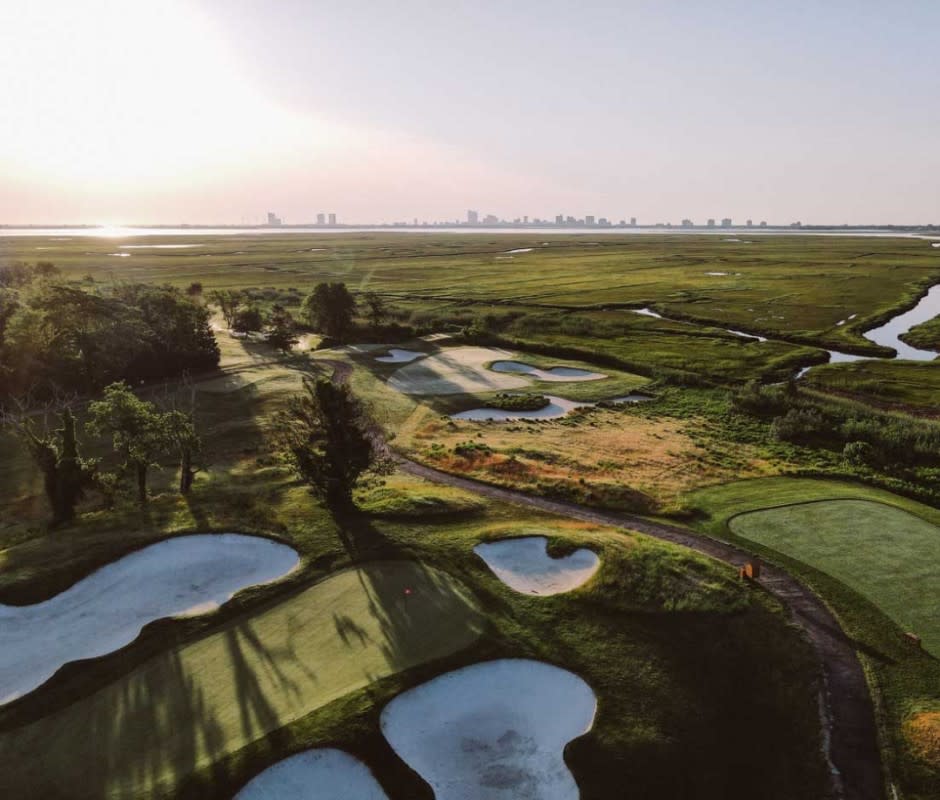
Sure, we’d all love to score a tee time at Pine Valley, the perennial top-ranked golf course in the world, but us mere mortals will have to sniff elsewhere in the Garden State. Enter Atlantic City Country Club, one of the oldest golf courses in the country.
It was established in 1897, and is—wait for it—the “birthplace of the birdie.” Legend has it the one-under term was first uttered here on the 12th hole in the winter of 1903. “That was a bird of a shot!” a player shouted. Today, a plaque commemorates the moment. History aside, a spectacular round awaits you here, and it comes with beautiful Atlantic City panoramas.
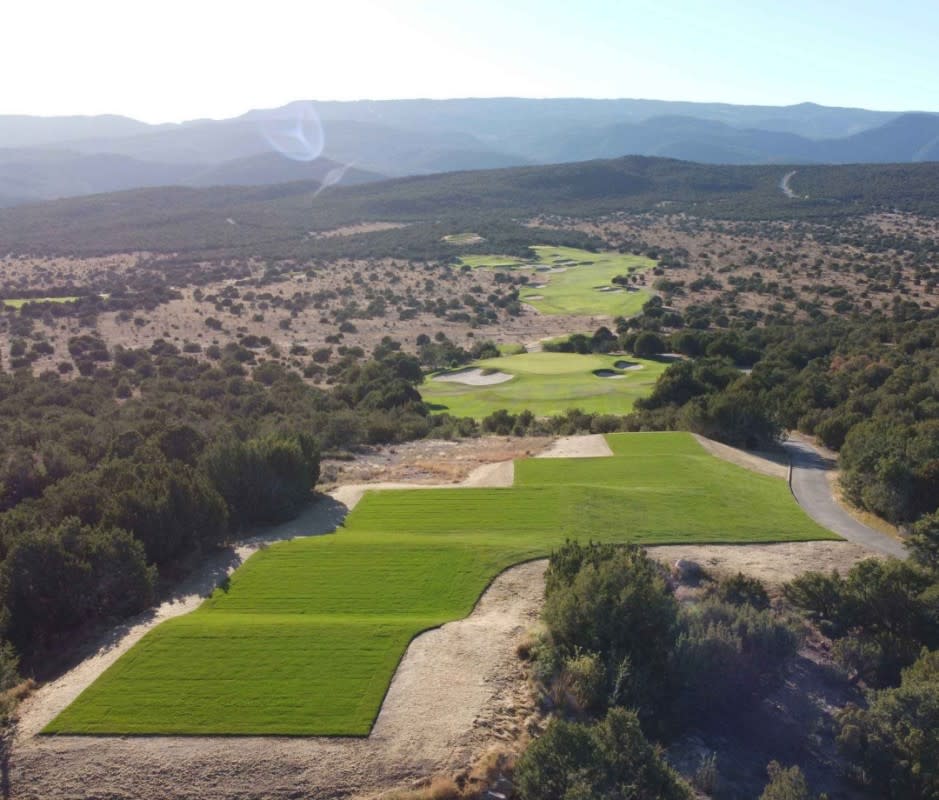
Paako Ridge is twenty-five minutes by car from Albuquerque, NM and tucked 6,500 feet above sea level—it’s bombs away in the thin air of the Land of Enchantment. You’ll need the extra length (the course plays long no matter the tee box) as fairways climb steep foothills, but they lead to buttes with incredible vistas of the Sandia Mountains (we’re looking at you, No. 17). Of the 27 holes here, no feature is more interesting than the fourth, where a 100-plus-yard green is a shoo-in to be the biggest putting surface you’ll ever encounter.

The Black Course at Bethpage State Park on Long Island is not merely the primo municipal golf course in America, it’s one of the most intimidating anywhere. Consider this your pre-warning before the official (and famous) warning sign on the first tee advising it to be played by “highly skilled golfers” only.
Tiger Woods conquered it at the 2002 U.S. Open; Brooks Koepka took home the Wanamaker Trophy there in 2019. Both fit the talent bill. For the rest of us, we’ll have to grow to love blind tee shots, uphill par-4s into blind greens, thicker-than-cabbage rough, and the virtuosic cross-bunkering laid out by A.W. Tillinghast. Otherwise, it’s a walk in the park, and a damn fun one at that.
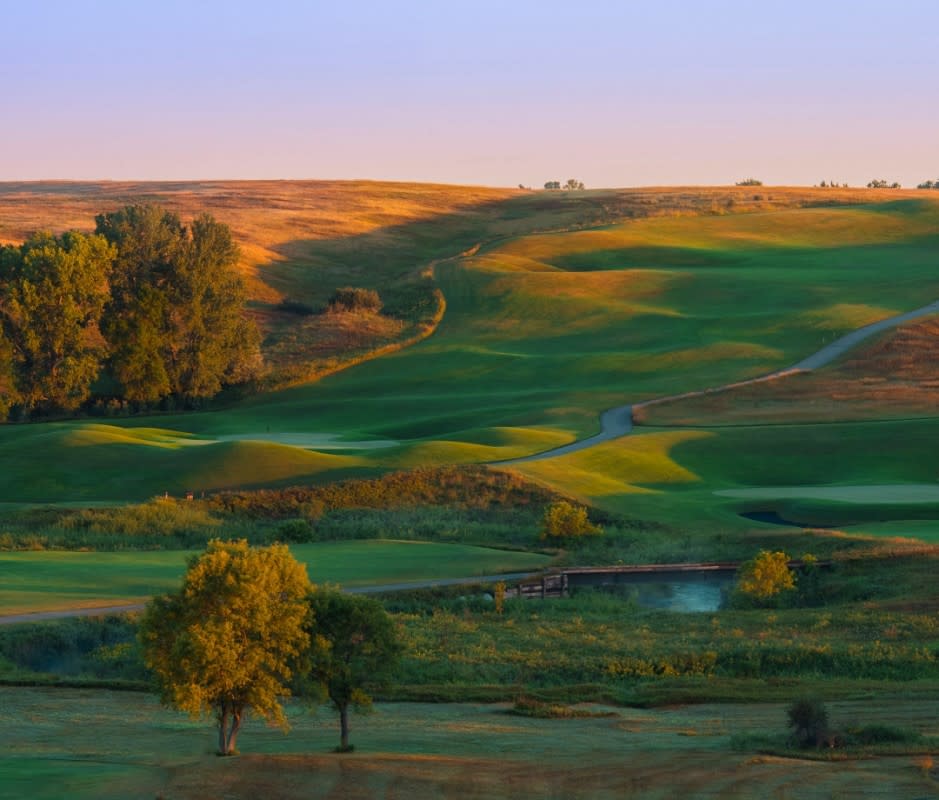
Expect steep hole-to-hole elevation changes and robust Midwestern winds at Jim Engh’s undulating design located outside North Dakota’s capital of Bismarck. While it’s never the preferred position to play from, you’ll want at least one go-at-it from Hawktree’s famed black sand bunkers that, from afar, resemble a Hawaiian beach. Technically, they’re filled with coal slag, a power plant byproduct that prevents sand traps from being blown out by the area’s notorious gusts.
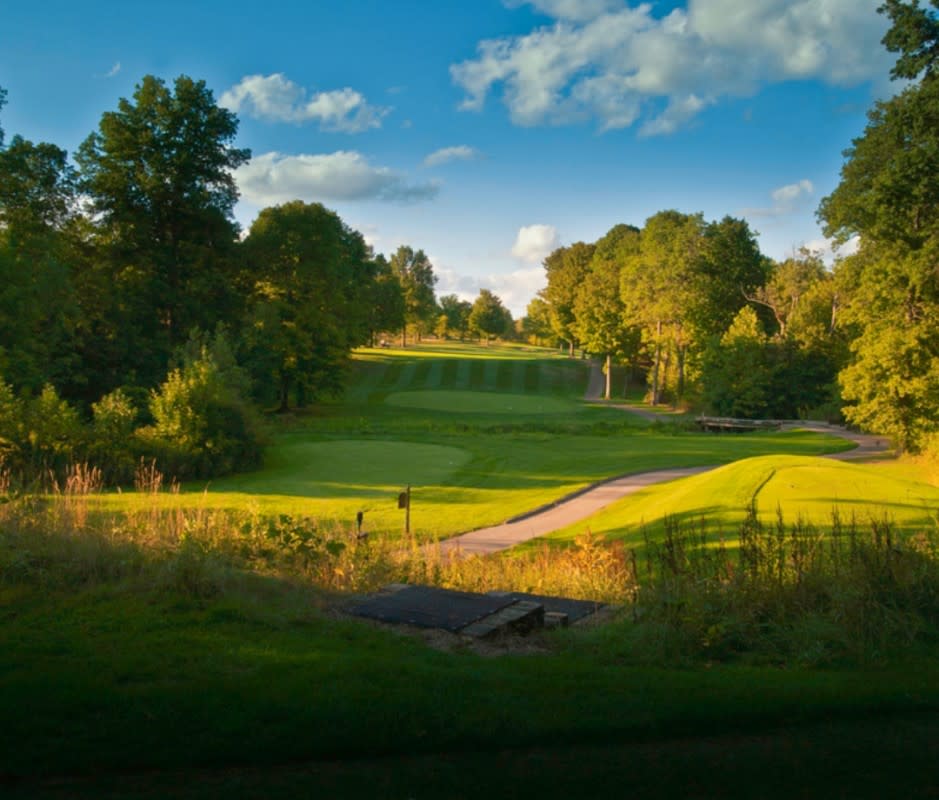
Death, taxes, and Pete Dye designing top-ranked golf courses—those are the three guarantees in life. Twenty-seven holes comprise this 50-year-old gem just outside Cleveland, OH, but it’s the Lake and River nines that produce the premier eighteen. Dye layouts are never short on fascination, and this entertaining ensemble in the Ohio countryside is a Buckeye State must-play.
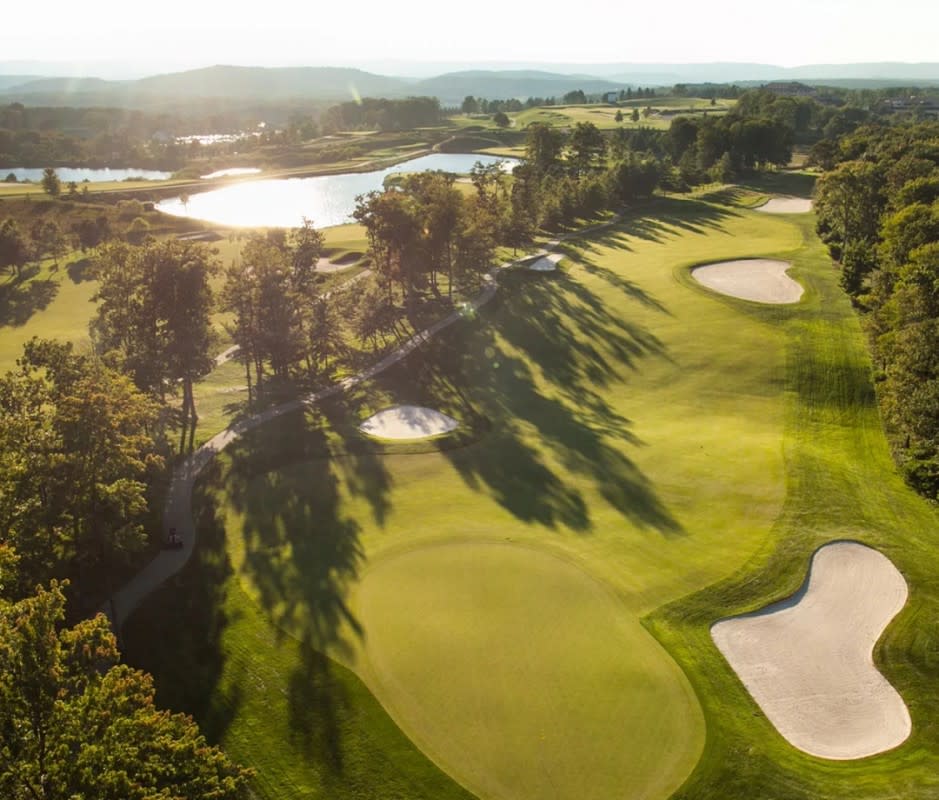
Wrapped by the Allegheny Mountains, another Pete Dye treasure beckons players to the Laurel Highlands of southwest Pennsylvania. Like any land touched by the Bury Me in a Pot Bunker author, this, too, is a championship-caliber test—it hosted the now-defunct 84 Lumber Classic for multiple years. Note to self before you tee off: Golf is meant to be fun, and to ensure said fun at Mystic Rock, be wise and jump one tee box closer. Capeesh?
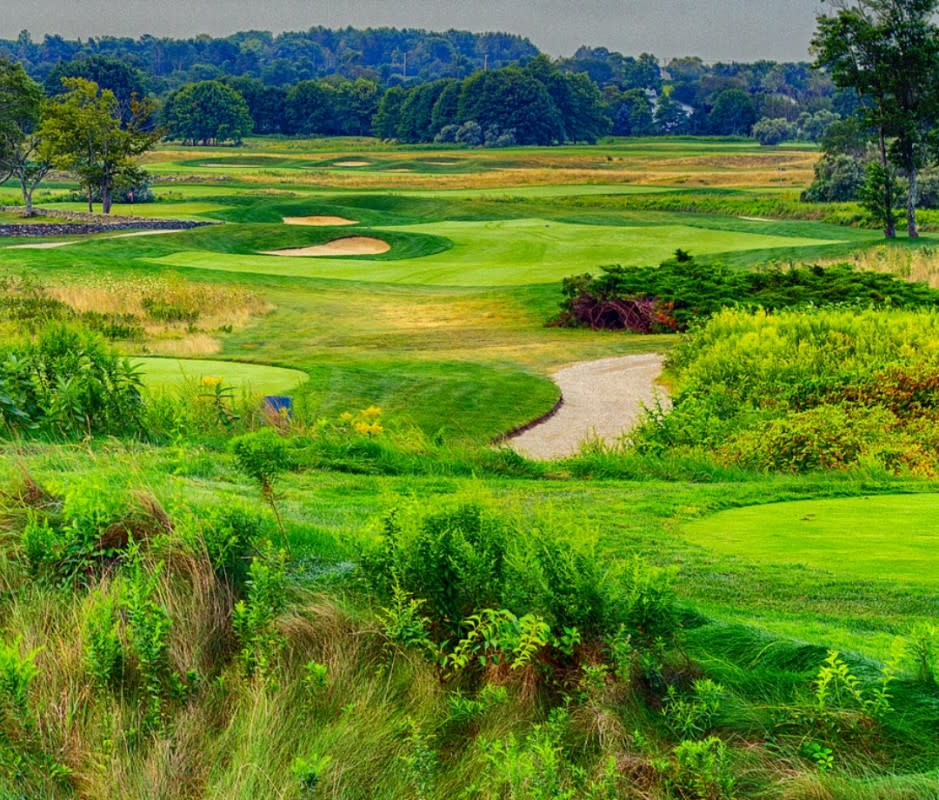
Located on the grounds of a former nursery, this links-style track in America’s smallest state will, remind you of a romp along the Irish coastline thanks to its Atlantic Ocean views, knee-high fescue, and gorse-like shrubbery. The foliage has a purpose: The course is a certified Audubon Cooperative Sanctuary. While you’re walking between holes, keep an eye out for birds that frequent the course’s nest boxes and treelines.
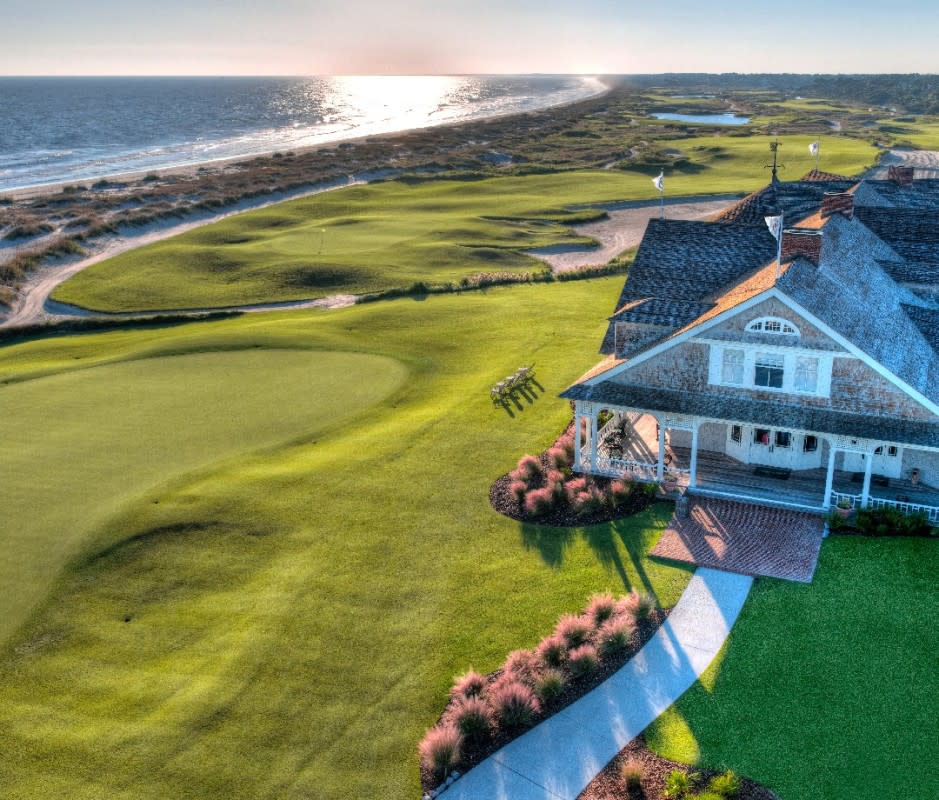
Courtesy Image
There’s no sugar coating it, Kiawah Island’s Ocean Course is a beast, and when the wind is blowing it’s a straight-up monster on steroids. Architect Pete Dye was known for dreaming up the game’s most difficult tracks, and the Ocean Course might be his most testing. A round is a bit like taking the SAT and the ACT in one day. The fairways are spare, the bunkers plentiful, and there’s water—lots of water. But it’s also simply a stunner. There are 10 holes directly adjacent to the Atlantic Ocean, many with fairways and greens that are elevated for unobstructed views of the waves.
It's accomplished a lot since its 1991 debut. That year, it hosted the legendary “War by the Shore” Ryder Cup, which ended in an American victory. In 2012 and 2021, respectively, it crowned Rory McIlroy and Phil Mickelson PGA Champions. Aside from golf, it also landed on the silver screen in 2000, when the Robert Redford-directed The Legend of Bagger Vance brought Will Smith, Matt Damon, and Charlize Theron to Kiawah’s coastline (stream it before you visit to tap into that Lowcountry magic and to collect a swing tip or two).
Today, the Ocean Course is a top 10 staple on public course lists, thanks in part to Dye’s better half, Alice, who had the idea to raise the tee boxes and fairways for better Atlantic Ocean views.
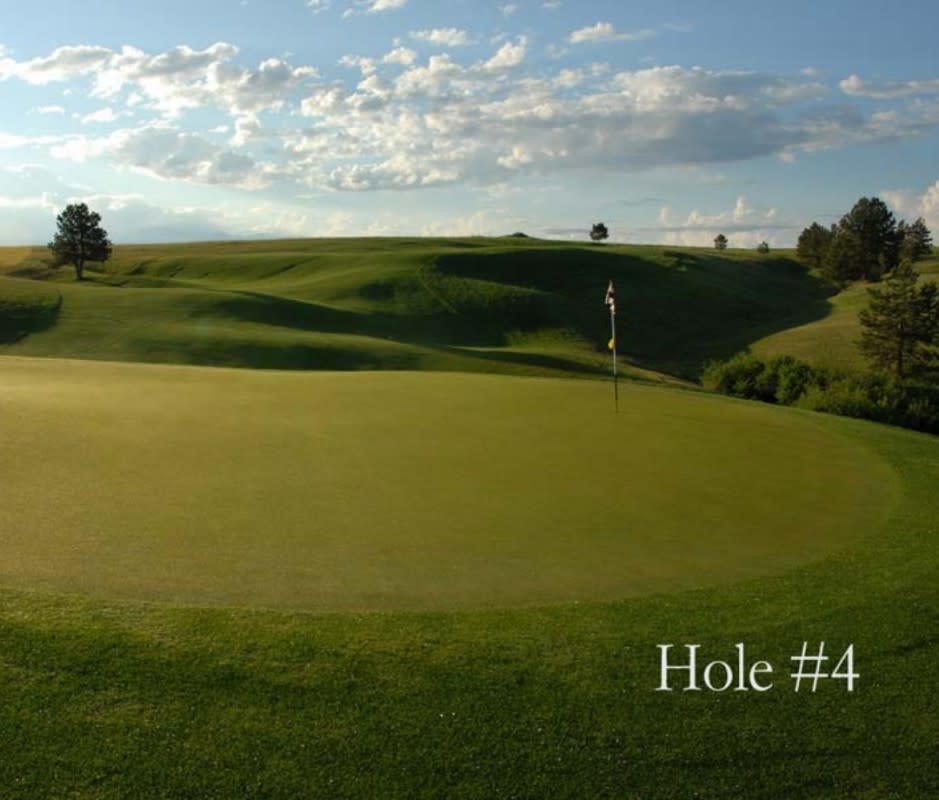
Close to the ex-mining town of Rapid City, this South Dakota layout weaves its way through ponderosa pines and rolling, fescue-rimmed topography at the edge of Black Hills National Forest. Sure to surprise players is the course’s elevation: It’s nearly 4,000 feet above sea level, which will add some always-appreciated bonus yardage to your drives.
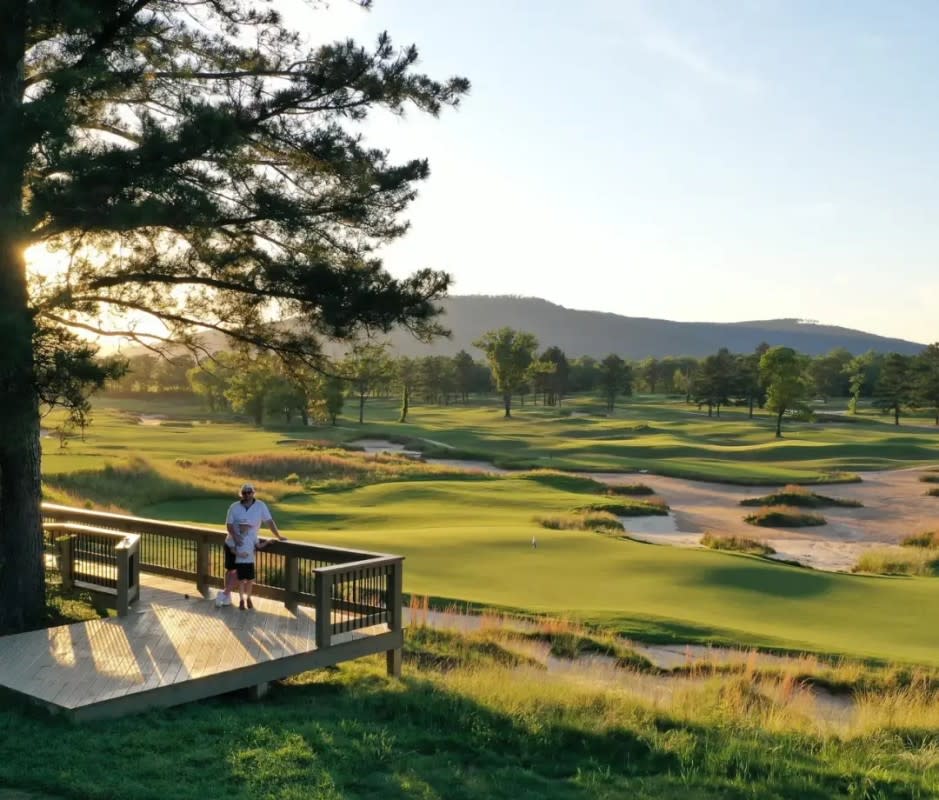
This little-nine-holer-that-could located thirty minutes from Chattanooga, TN has become a certified cult favorite amongst the golferati (even Peyton Manning and Andy Roddick have invested). Some have called it “Augusta on acid” while others liken it to Tin Cup meets Field of Dreams. However you describe it, the ethos here is laid back (golfers can wear what they want and even bring their dog along), but the aura is bordering on spiritual. One visit, and you’ll understand what that means.
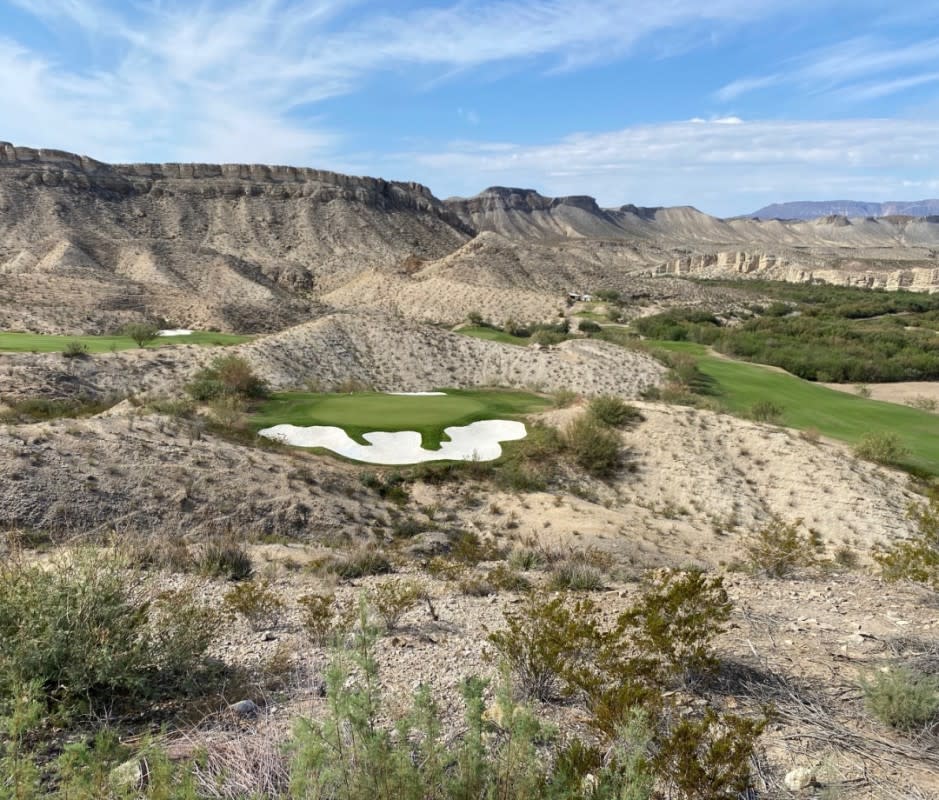
A trip to Black Jack’s Crossing at Lajitas Golf Resort is about as deep into the heart of West Texas as one can get. Brushing up against the Mexican border between Big Bend National Park and the Rio Grande, this Lanny Watkins design snakes its way through a Wild West landscape of dry washes, towering rock canyons, and sprawling Chihuahuan Desert vastness. You’ll feel like a cowboy when you check in at the pro shop—it’s housed in the Lajitas Trading Post, built in 1899.

Not far from St. George, UT and Zion National Park, a manmade network of greenscape hangs high on southwestern Utah’s red rock cliffs. The John Fought and Andy Staples blueprint feels like you’re playing on the movie set of an old Western. The course’s famed back nine runs along an elevated ridgeline, and myriad pinch-me vistas await you starting on the 12th tee.
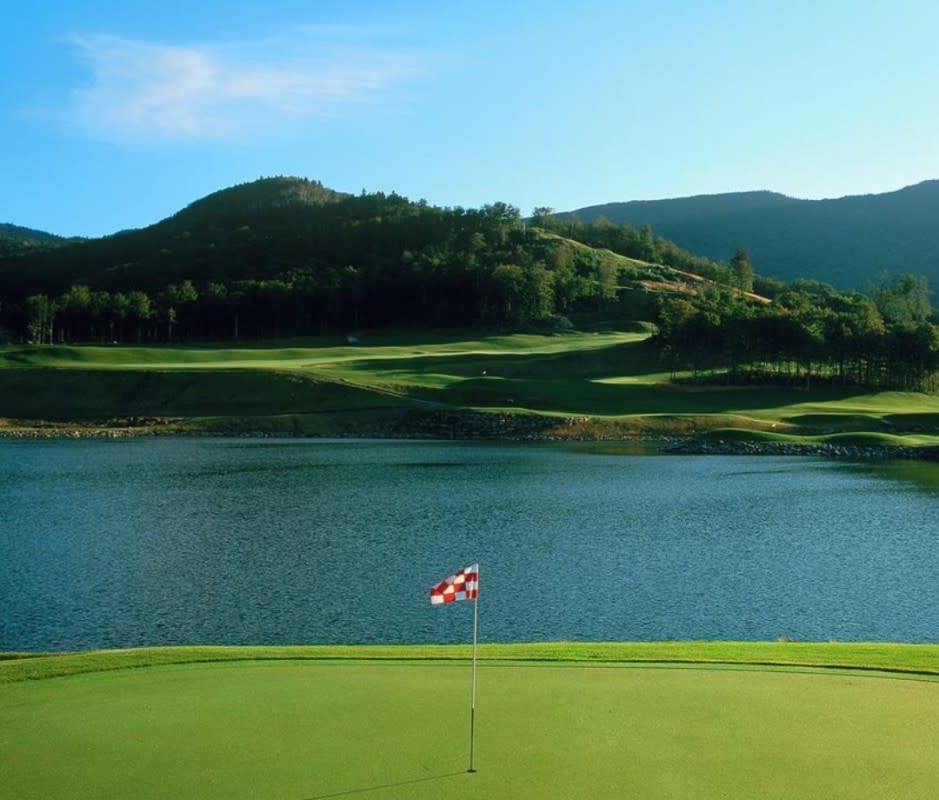
The par-3 sixth hole at this Green Mountain State track, previously known as Stowe Mountain Club, says it all. The sink-or-swim shot plays over Peregrine Lake into a sliver of a green backdropped by Stowe’s high and mighty forested ski slopes. Come in October for a real show: Vermont’s ethereal fall foliage blazes in every direction.
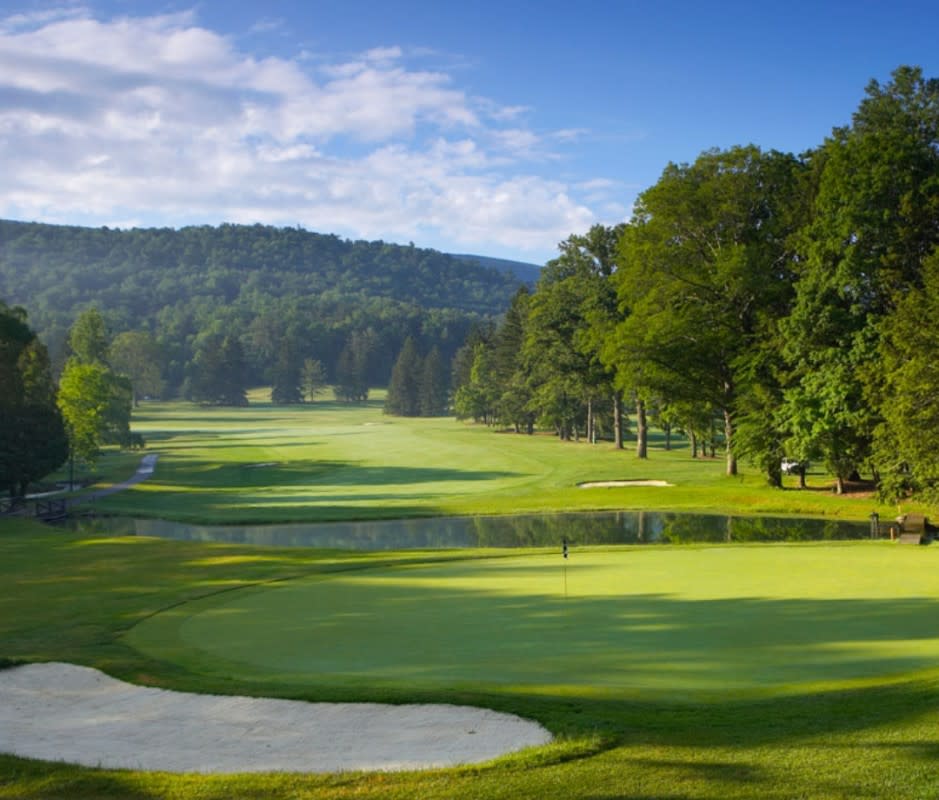
Travel here for a sublime Golden Age layout at a historic resort in the verdant Allegheny Mountains. You’ll be retracing the footsteps of a legend: The course served as the launch pad for 82-time PGA Tour winner Slammin’ Sammy Snead. Prepare yourself for rolling Appalachian topography and fantastic cross-bunkering before your round closes with a rare three-hole stretch (16 through 18) that features back-to-back par-5s and a finishing par-3.

When Scottish architect David McLay Kidd, of Bandon Dunes fame, was given the opportunity to build a course in the middle of cherry-and-apple-orchard country, he had one word on his mind: fun. That’s the name of the game at this course on the bluffs of the Columbia River in the high desert of eastern Washington. It boasts wide, rambling fairways that funnel towards safety, not penalty, and multiple short par-4s and reachable par-5s. Post-round, grab your flatstick and soak up mountain scenery on its wild 100,000-square-foot putting course.

Courtesy Image
Charles Blair Macdonald’s 1913 classic design features tight fairways playing through the beauty of the Appalachian forest. Small, well-guarded greens are the norm here and approach shots will test most players’ mettle. There are only two par-fives, both on the back nine, making the Old White a par-70 golf course, which also deploys a tremendous collection of par-threes. The third features a Biarritz green, split by what is called the "valley of sin." The idyllic Redan eighth hole is templated on the original at Scotland's North Berwick, and the 15th pays homage to the Eden hole at St. Andrews. The Old White concludes on the short "Home" hole, which plays over the stream to a good-size putting surface and a chance to finish the round on a high note.
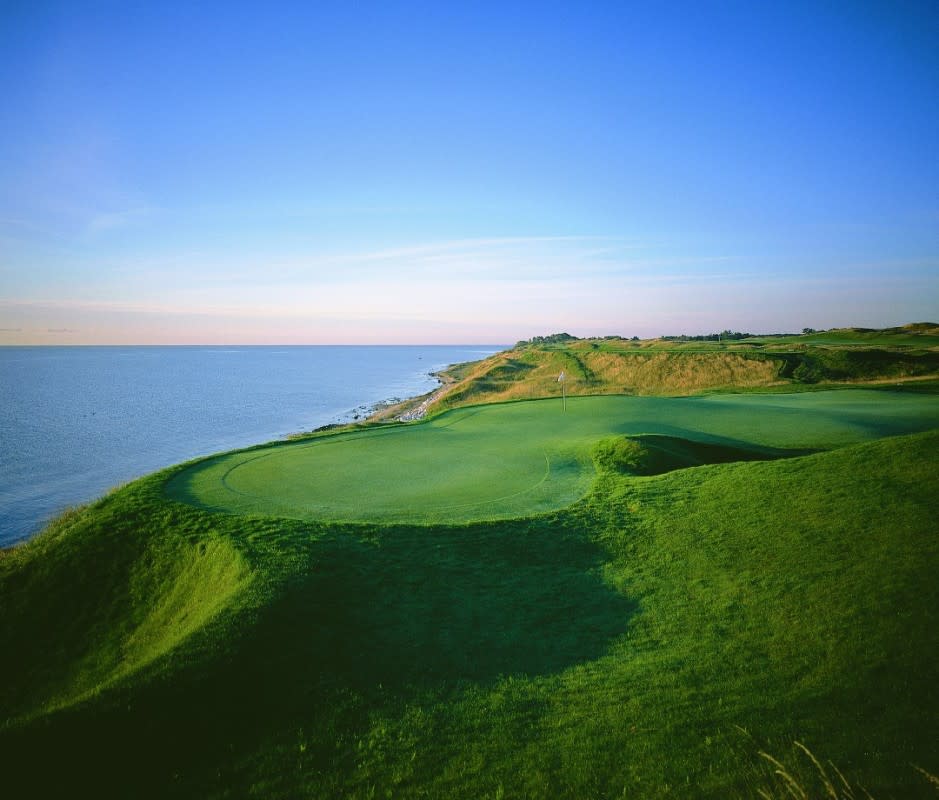
Courtesy image
Designer Pete Dye used 13,000 truckloads of sand and countless bulldozers to create the Whistling Straits course, his tribute to Irish golf along the flat Wisconsin shore of Lake Michigan. A little over an hour from Milwaukee, in Sheboygan, the par-72 course measures 7,790 yards, but when the winds are up, it plays much longer. It’s both telegenic as well as tough, which is why The Straits hosted the 2004, ’10 and ’15 PGA Championships as well as the 2021 Ryder Cup. It’s walking only, so eat your Wheaties before a round or take a caddy who can help give the lay of the land. Probably a good idea to have someone to talk shots through with since there are more than 1,000 bunkers to avoid. But if you choose to go it alone, we wish you the best of luck.

Just outside the ski mecca of Jackson Hole in tiny Wilson, WY sits a golfing utopia in the Rockies. Teton Pines, perched some 6,200 feet above sea level, dazzles with paper-white sand traps, hypnotic views of the Teton Range, and an 18-hole Arnold Palmer layout that’s every bit as fun as it is picturesque. Pack your binoculars along with your rangefinder: Bears, moose, and elk are often seen crossing the fairways.
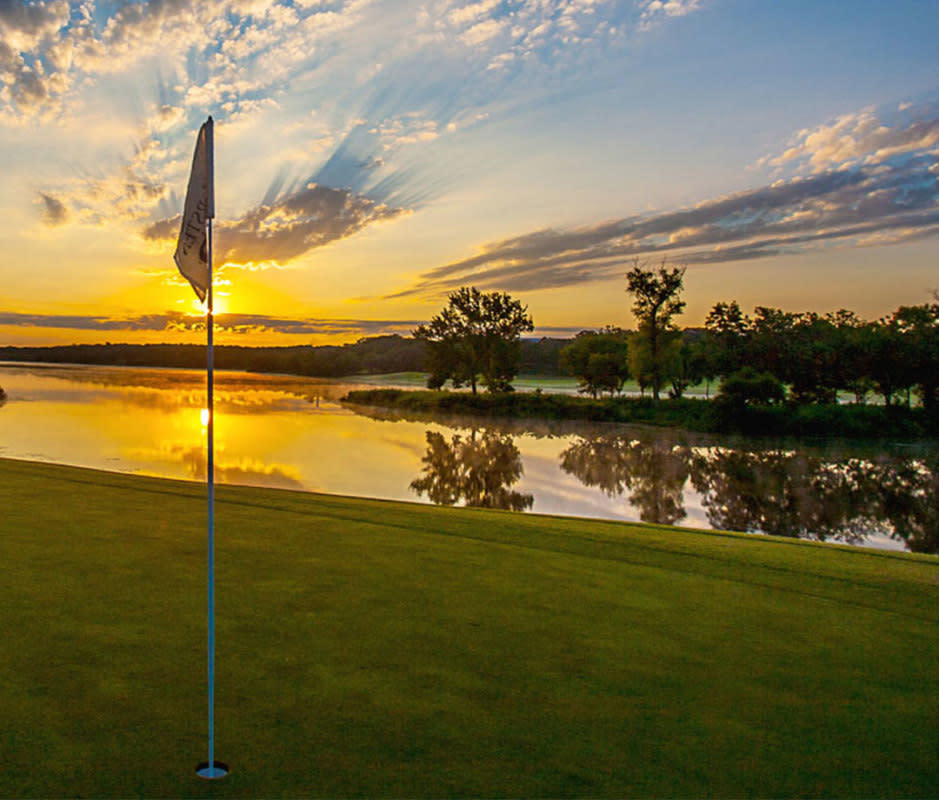
Courtesy Image
Developed by Oklahoma State University as its home course and designed by Tom Doak, Karsten Creek Club was named for the late founder of Ping, Karsten Solheim, a booster of the school’s golf programs. As to be expected at a training ground for top-level collegiate athletes, the course represents a test of shotmaking. Nearly every hole puts a premium on accuracy, both off the tee to avoid tree trouble and on approaches into tricky greens, where two putts are not a given. Karsten Creek's signature hole, the 209-yard, par-three demands a tee-shot over water into the prevailing wind. But clubbing up can lead to trouble since there’s water behind the green as well.
Note: Karsten Creek is currently under renovation by Andrew Green and is anticipated to re-open in spring 2025.
How We Chose the Best Golf Courses
In making our selections for the best public golf courses in the U.S., we considered a multitude of factors. We evaluated notoriety, reputation among players, architectural influence, as well as the test they present to players at all levels. But we also wanted to give a bit of weight to the “fun factor.” After all, golf is a game and it’s meant to be both a challenge and pleasurable. The end curation offers geographic diversity to better service golfers around the continental U.S.
And since this guide is broken down by state, every corner of America gets a turn at the podium. Some courses are high-priced Top 100s (like TPC Sawgrass in Florida) that bucket-list golfers yearn to play once before they’re buried in a pot bunker à la Pete Dye. Others are up-and-coming hotbeds in less-visited states (Big Cedar Lodge in southwest Missouri comes to mind). Then, of course, there are the certified steals that you could make your home course and play over and over again (Circling Raven in Idaho, we’re looking at you).
Why You Should Trust Us
Nicholas McClelland hasn't been playing golf all his life. He came to the game a bit late, but fell hard. Some people would say he's now obsessed with the game. He's a gearhead, always ready to rip the latest driver or wedge, and passionate about architecture and design. Ask him where his favorite two golf courses in the world are, and most days he'll point toward Scotland—specifically, in the direction of The Old Course and Royal Dornoch—but he has plenty of other favorite fairways closer to home. His clubs are usually in the back of his car (just in case) and he often packs them on non-golf trips for the same reason. If he's slow to respond to an email, he's probably having a good back nine.

